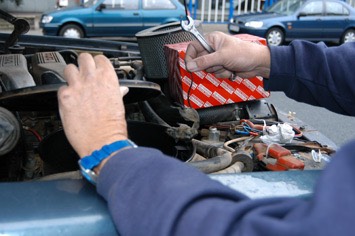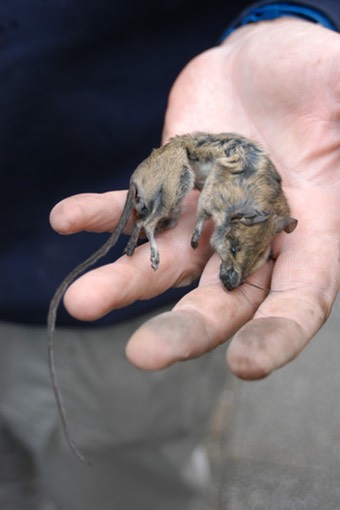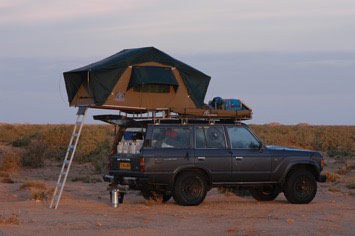 After working in the desolate wastes of the North Sea, we longed for an adventure of the terrestrial kind. We bought a 1980s Landcruiser from Chris Scott, author of "Sahara Overland", and naturally christened the car Scottie. We set off from Germany for a three month round trip to Senegal and the Gambia. This is our diary. We also presented a poster at the European Cetacean Society conference 2005, based on the whale, dolphin and turtles bones we found and catalogued during this trip. There is a link to this poster here.
After working in the desolate wastes of the North Sea, we longed for an adventure of the terrestrial kind. We bought a 1980s Landcruiser from Chris Scott, author of "Sahara Overland", and naturally christened the car Scottie. We set off from Germany for a three month round trip to Senegal and the Gambia. This is our diary. We also presented a poster at the European Cetacean Society conference 2005, based on the whale, dolphin and turtles bones we found and catalogued during this trip. There is a link to this poster here.
Mick: Scottie the car gave us a fright the day before we were due to set off, when we went to the self-help garage in Bremen to change the oil. The starter jammed right in the garage entrance. Chris had warned of this possibility, but in my experience a jammed starter just meant the thing made impotent clicking noises when you turned the key. So I was unprepared for the fairly dramatic symptoms of a starter that just keeps turning the engine over, even when the ignition is switched off – with horrible screeching noises and smoke coming from under the bonnet I immediately understood why there was an unfamiliar quick-release connector on the earth side of the batteries!
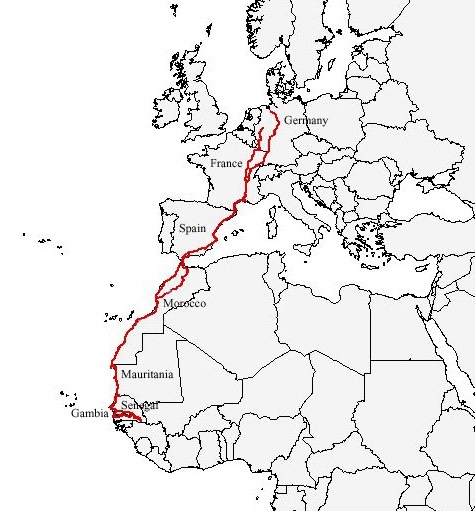
Friday, 19/12/2003: Bremen – Saarbruecken, 524 km
We finally left Bremen and drove down to Saarbruecken, burning the foul smelling but cheaper bio diesel. There we stayed with Maren’s friend, Diana, whom she hadn’t seen for nearly seven years! What a great reunion!
Saturday, 20/12/2003: Saarbruecken – Saintes Maries de la Mer, 763 km
Today we drove at high speed down the peage motorways of France to Saintes Maries de la Mer in the Camargue. At one of the toll stops a familiar sounding horn blew next to us, and there was a Gallic-moustached driver of an identical Landcruiser HJ61 grinning at us.
Sunday, 21/12/2003: Saintes Maries de la Mer – Vall de Laguar, 791 km
Today took us to a remote hill-top camp site near Alicante called Vall de Laguar. Excellent tapas and extremely cheap, especially compared with the very expensive, though delicious, meal we treated ourselves to in Saintes Maries.
Monday, 22/12/2003: Vall de Laguar – Jimena de la Frontera, 670 km
We made it down to Algeciras, bought ferry tickets for the next morning and plunged into the huge Carrefour supermarket to fill our food boxes. Then spent the night at our favourite camp site in Jimena de la Frontera, the only people there.
Tuesday, 23/12/2003: Jimena de la Frontera – Moulay Bousselham,
214 km
We managed to catch the fast ferry to Ceuta at 9:15 in the morning. With a mixture of amusement and dismay we shared the crossing with a whole hoard of crazy old bangers taking part in the Plymouth – Dakar rally. Despite a sea state of five or so, we saw a group of around ten common dolphins just outside Algeciras bay – a moment Maren found so exciting she shook Mick’s arm vigorously spraying coffee all over Mick and herself! (Maren: Seeing dolphins after several months out on the North Sea without any sightings was just too exciting!). After filling the fuel tank and jerry cans with Ceuta’s cheap diesel (140 litres for 66 Euro) it took hours to get through the border because of all the rally folk. At last they let us through and we drove down to Tetuan and up over the hills, passing a flock of around a hundred storks, to arrive at the Atlantic coast and our Christmas haven at Moulay Bousselham. The camp site close to the Ramsar listed lake had only two other camper vans – German and Venezuelan. The trees and garden shrubs were alive with willow warblers, serins, goldfinches and black redstarts.
Wednesday, 24/12/2003: Stationary at Moulay Bousselham
We were woken by the loud singing of bulbuls. Marsh harriers hunting the lake margins soared overhead. We walked into the village for Maren’s first taste of mint tea and bought some bread, fresh meat and vegetables for our Christmas Eve dinner of lamb curry. In the afternoon we took a boat trip on the lake with English-speaking Hassan. He knew his birds well, bemoaned the demise of the slender-billed curlew, and was very careful to avoid disturbing the birds. There were many thousands of duck (wigeon, teal, mallard, pintail, shoveller), a huge flock of avocets, flamingos, sandwich and Caspian terns, godwits, grey plover, curlew, and whimbrel. After the two hour trip Hassan showed us the African marsh owls, a speciality of the site, which in fact flew right over our camp site.
Thursday, 25/12/2003: Moulay Bousselham – Essaouira, 504 km
On Christmas Day we drove down the motorway (yes, the real thing complete with peage stations, but lots of people just hanging out or walking down the motorway just like any other road) to Essaouira. The camp site was full of camper vans and tents, mainly French and German. Dusk was approaching as we unfolded the roof-top tent, so we walked along the corniche into the town to explore the souk before choosing a restaurant for our Christmas day dinner of chicken tajine. Outstanding! Then another stroll through a less touristy souk, where little knots of people gathered around stalls to eat snails, and everyone seemed to be out for a walk in the lively little town.
Friday, 26/12/2003: Essaouira – Tiznit, 255 km
Heading towards Agadir, we passed a massive encampment of camper vans – several hundred on the cliff tops overlooking long sandy beaches. There were lots of surfers too in some spots. As we descended through hairpin bends towards the coastal plain, at one point we saw two boldly-striped Barbary ground squirrels - our first wild mammals of the trip (not counting the two Barbary apes held in a depressingly small cage at the campsite in Moulay Bousselham). We got lost in the industrial suburbs of Agadir before finding our way to the Sous Massa National Park. Crossing the Sous the landscape looked scrappy and heavily populated, so we pressed on to the southern of the two rivers, eventually entering the park at the head of the Massa estuary. There is a pleasantly long walk along the northern bank to the sea, but deviation off the track is not permitted. Although there was a sizeable flock of glossy ibis, we could not find the rare bald ibis. But there were osprey, peregrine, Moussier’s redstart, cranes, pochard, dabchicks, snipe and common sandpipers. Finding nowhere suitable to camp we carried on to Tiznit, where again the campsite was fairly full, including some of the rally cars we last saw in Ceuta.
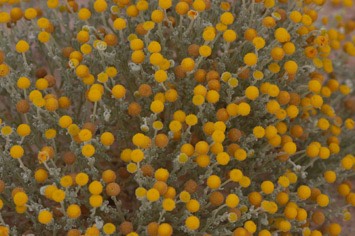
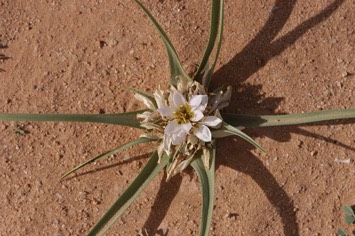
Saturday, 27/12/2003: Tiznit – south of Layoune, 512 km
Woken early in the morning (6:00) by the competing muezzins of Tiznit, we headed south towards Layoune, the New Town of what once was the Western Sahara. At one point we were astonished to see a new Landcruiser, which had been converted into an open car, speeding across the desert filled with important looking dudes in red headdresses. A second similar car approached and we could see they were carrying falcons on their hands. Wealthy Arab falconers! As the landscape became dryer and vegetation more sparse, the birds changed too. A long legged buzzard settled to give us good views and then we started seeing different species of wheatears and larks. Cap Juby was rather disappointing so we carried on to a beach resort just south of Layoune, where we camped in a vast empty campsite together with an English couple on a motorbike and a couple of the rally cars. One of these was a Russian Lada Niva that had driven all the way from Moscow.
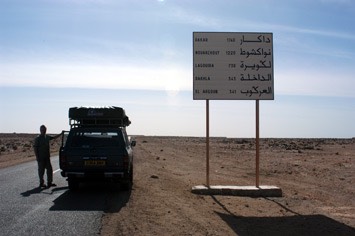
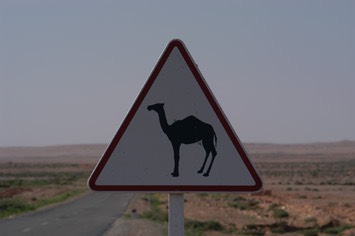
Sunday, 28/12/2003: South of Layoune – north of Dakhla, 416 km
Today we travelled south through the increasingly arid landscape, filling up on the incredibly cheap, subsidised diesel (about 26 Eurocents/L). Access to the sea was limited by the dangerously crumbling sandstone cliffs, but we came across a new tarmac road down to the beach. There were several groups of people down there, mainly Arab families and fishermen and one big German hippy truck. Right next to where we parked, we found a piece of harbour porpoise jaw with the characteristic spade-shaped teeth! We camped in the desert not far from the Dakhla turn-off, watching hoopoe larks doing their manic aerial display and tried stalking desert wheatears and Thekla larks to photograph them.

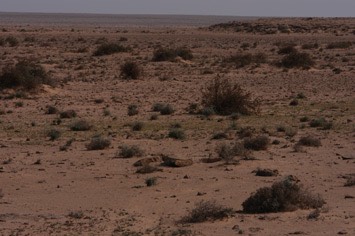
Monday, 29/12/2003: North of Dakhla – Whalebone Camp, 180 km
Because our Mauritanian visas were dated for January 1st we needed to find somewhere to camp for a couple of days. We had intended this to be Cintra Bay, so we drove out on the bleached sandy piste along the headland that forms the northern arm of the bay. To our surprise, the bay was a vast dry expanse of sand – it is really a sebkha, a seasonal lake rather than a sea bay. Finally reaching the end we came to a fishing village on the headland – a collection of huts, piles of nets and buoys, with a couple of small tractors working their way through the narrow lanes between the huts. As we sat and looked, wondering whether to turn back, a soldier and policemen came out to meet us. After the usual greetings they asked if we had any beer. Alas no, we lied. They politely suggested we go elsewhere, and so we did. Pressing ever further south towards the border, we at last found a way to drive off the road towards the sea, and threaded our way across mainly hard sand and stones to a thin line of tamarisk bushes behind the low dunes that backed a long beach. As we pulled Scottie in behind the largest bush, we saw the huge bones of long dead whales – ribs and vertebrae scattered around our campsite. This seemed like a good omen, so we stayed at “Whalebone Camp” until New Year’s Day.
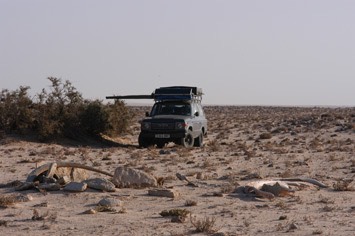
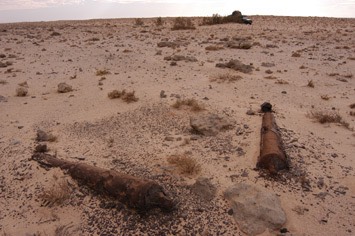
Tuesday, 30/12/2003 and Wednesday, 31/12/2003: Stationary at Whalebone camp
We spent the cool of the mornings searching for whale bones, but in the afternoons a strong wind got up, persisting late into the evenings. Exploring the beach in both directions we found scores of whalebones from several different species, including one almost complete skeleton. We didn’t actually walk more than about three kilometres in each direction, but we found more than 70 different whale and dolphin bones! There were turtle bones too, and one very manky carapace of a leatherback turtle. Caspian terns patrolled the shore, along with Audouin’s gulls and several wader species (turnstones, grey, kentish & ringed plovers, whimbrel). It felt good to come to a rest at last, despite the wind-blown sand and plagues of flies, and we were completely alone except for the jackals and small rodents (jerboas?) that shared our camp site. We saw their footprints everywhere, but didn’t get to see the animals themselves despite looking around at midnight on New Year’s Eve. We started the New Year gazing at the moonlit desert from the height of our rooftop tent.

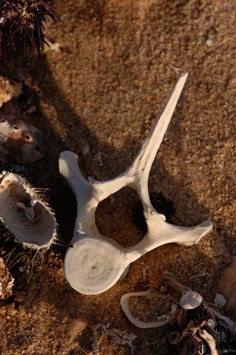
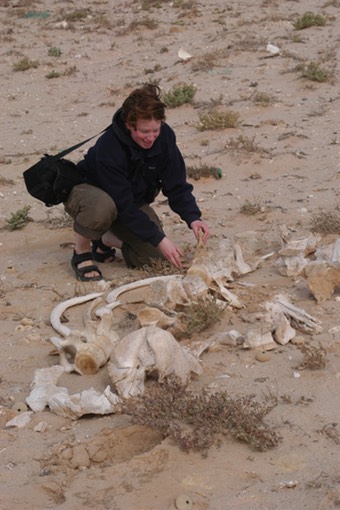
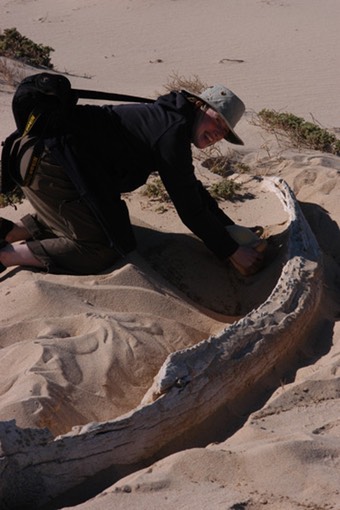
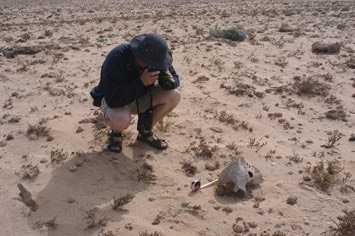
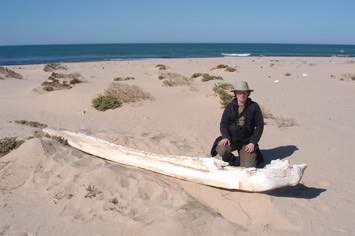
Thursday, 01/01/2004: Whalebone camp – Nouadhibou, 210 km
It took us about two hours to get to the Moroccan checkpoint of Fort Guergerat, which is not much more than a dusty space with some huts scattered around it. There wasn’t much traffic, so we were on our way again after less than two hours. After Fort Guergerat the real adventure began – there were no tarmac roads any longer, just pistes. We had good directions and waypoints for orientation, but it still feels very strange to know that all the area around you is full of landmines that haven’t been cleared yet! The last Moroccan checkpoint was another little hut in the middle of nowhere. We carried on for several kilometres until we came to another set of huts, which – as we discovered later – was actually the Mauritanian border!!! All the officials were really friendly and asked us into their offices which were their homes at the same time! Unbelievable how they lived there with scores of flies and cockroaches! Also we were now in an area, where everybody asked us for “cadeaux”; little gifts for letting us through checkpoints and so on. After 90 minutes of driving through the deserted border area of Morocco and Mauritania, we finally converged on the railway going to Choum in eastern Mauritania. From there on we just followed the railway into Nouadhibou, which took more than two hours for something like 30 km! Arriving in a campsite where all the overlanders gather, we were well shaken up and knackered after a long day’s drive.
Friday, 02/01/2004: Day trip to Cap Blanc, 44 km
We drove from Nouadhibou down to Cap Blanc – only a short distance but the piste was not signposted so we got lost and ended up in a rifle firing range! Actually the piste ran alongside the range which was a bit nerve-wracking. Following directions from a National Park ranger, we climbed down onto the beach near a big ship that had been washed ashore, and walked along under the cliffs in search of monk seals, but the tide was high so none were hauled out. Scanning from the cliff top we saw two harbour porpoises heading west past the cape. On the way we had to stop at the level crossing for the longest train in the world – it carries iron ore between Choum and the port. The port itself is full of wrecked trawlers and coasters; it really is an unbelievable sight. On a nearby refinery a flock of about 40 black kites settled to roost. We also saw several ospreys, all sitting on the ground. A power cut in the city in the evening caused much excitement with the personnel in the teleboutique while Maren called home. While the power was still off we enjoyed a candle lit dinner at a small local restaurant “Les Trois Etoiles”.
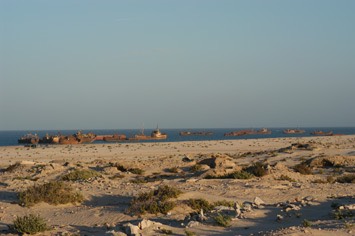
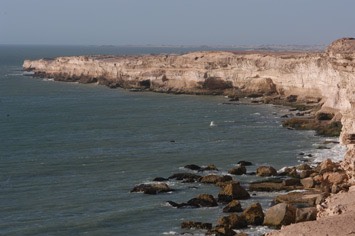
Saturday, 03/01/2004: Nouadhibou – Cap Tagarit, 214 km
We left Nouadhibou at 7:30, heading towards Nouakchott, the capital of Mauritania. We followed the railway line and turned off on the piste OK, which runs along the shore of the Baie du Levrier. Feeling pretty confident of the route we didn’t stick to the GPS waypoints but just followed the most prominent tracks in the sand. After some time we noticed that we were heading some 10 or more kilometres inland from our waypointed route and the piste was very deeply rutted. Guessing we were on the truck piste, we headed across open desert to rejoin our intended route. We encountered some pretty soft sand, but Scottie coped well after we let the tyre pressure down a bit. On the way, we also came across an enormous swarm of young locusts seething across the dunes. It was an truly awesome sight! After rejoining the piste, we made our way to Cap Tafarit in the Banc d’Arguin National Park, but the nearby Cap Tagarit looked more interesting so we set up camp there. There we saw a group of around twelve roseate terns- a scarce seabird that breeds in the UK - resting on a sand bank.
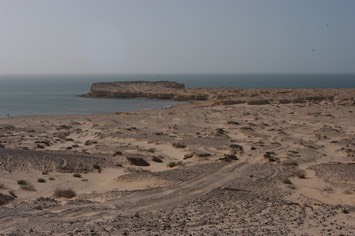

Sunday, 04/01/2004: Stationary at Cap Tagarit
First thing in the morning, we explored the small headland – sandstone covered in nuggets of iron ore. A Mauritanian told us there were striped hyenas there but we saw only jackal footprints. Fishing was excellent – Mick caught a splendid spotted bass which we grilled over charcoal for supper. There were many pallid and little swifts, ospreys, Lanner falcon, Caspian terns, godwits, knots, dunlins, common sandpipers, reef egret and pelicans.
Monday, 05/01/2004: Cap Tagarit – Nouakchott, 256 km
Today we continued on to Nouakchott. The dune crossings en route were no problem for Scottie. At the National Park border at Nouamghar there are two baleen whale skeletons outside the checkpoint. The ranger did not know the species but said another whale had stranded nearby on 10/01/2003 but had not yet decomposed enough to recover the bones. We set off on the 175 km piste along the beach as the tide began to recede with two Swiss cars, but they soon left us behind as we started finding dolphin bones. The need to press on and get to the end of the beach before the tide came back in meant that we couldn’t search properly for strandings, but we found and photographed two dolphin skulls and one full dolphin skeleton, including the skull, and one recently stranded leatherback turtle. Running behind schedule, we had to drive fairly fast, which meant lots of bounces over the many sand ridges – much sound of crashing food and kitchen equipment from the back of the car. We passed through many large flocks of lesser black-backed gulls that rose up off the sand to envelope us in a cloud of birds as we dashed through. Scottie nearly got stuck in a couple of difficult detours through soft sand to avoid rocks on the beach, but at last we made it to the end and turned inland onto firmer ground. Nouakchott appeared to be set in a vast sea of refuse. A large jackal crossed in front of the car as we approached the city. A recommended campsite in the city didn’t seem to exist any longer, but, after some searching, we found a decent campsite called Tergite on the beach.
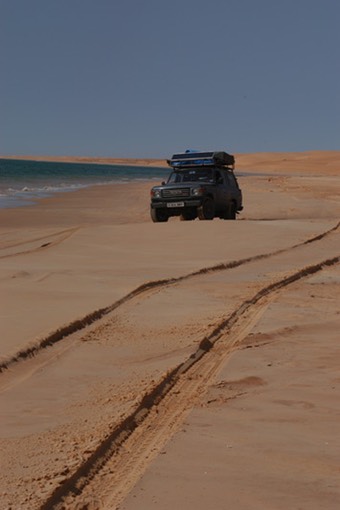
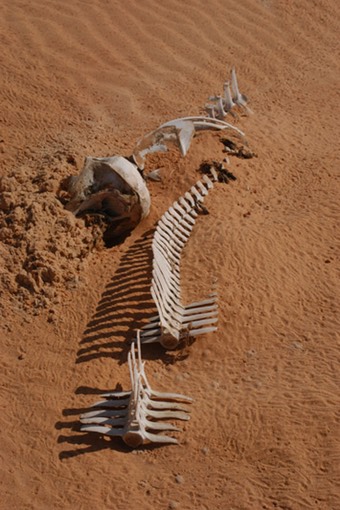
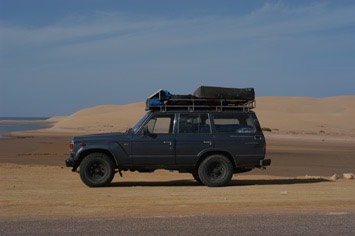
Tuesday, 06/01/2004: Nouakchott – Zebrabar south of St Louis, 313 km
As we headed south the vegetation changed into Sahelian dry acacia bush, with bare dunes near villages where goats had grazed away the fragile cover of grass. Birds started to appear again, including Namaqua and other doves, and an Abyssinian roller. A striped ground squirrel ran across the road. Then, as we approached one of the routine checkpoints, we came up behind five of the crazy rally cars! We overtook them rapidly so we could get to the border first. We arrived at Rosso on the Senegal river, where a bunch of young hustlers clustered around the car, but they were friendly enough and pointed out the way to the Diama dam border crossing. The piste to Diama was excellent, passing at first through farmland where there were several checkpoints with annoying policemen who asked for cadeaux (This time they even wanted bottles of perfume!) and needed several minutes of chatting to before we could get away without giving them anything. But then the countryside turned wetter, with large beds of some kind of sedge (?), some being burned nearer settlements, then open pools with spectacular bird life – black storks, European spoonbills, pelicans, harriers, ospreys, black kites, crowned cranes and our first African vulture. Warthogs ran across the road. Nearing the border crossing we entered a National Park that looked like it would be well worth exploring further on our return. Our apprehensions about the border crossing into Senegal turned out to be entirely unnecessary. Arriving at the Mauritanian side of the dam at 14:30, we found there was no sign of anyone else crossing. The Mauritanian officials were very friendly and helpful as usual - the policeman wearing a Rivaldo T-shirt took out a new exercise book with football motifs on the covers, ruled in columns with a ball-point pen, and filled in our details. After some discussion about who were the best footballers in the world, he waved us across his side of the border. We crossed the dam with Senegal thick-knees and whiskered/black terns flying about, only to see one of the Russian rally drivers walking across in front of us holding a clutch plate. They were stuck there with no carnet de passage and insufficient funds to pay for an official escort through the country to the Gambia, so they were holding a little sale of spare parts to raise the cash! Otherwise, no-one else was crossing. There were no hustlers and it took very little time to go through police formalities. Then to the customs office, where we were sat down in front of a TV set while our carnet was stamped, and then to buy insurance from a very business-like African Lady. And so into Senegal! We made our way past the outskirts of St Louis to the Zebrabar campsite, where the entire bunch of around 30 Plymouth – Dakar rally cars were noisily encamped.
Wednesday, 07/01/2004: Stationary at Zebrabar
In the morning, we watched the rally leave Zebrabar for the Gambia with their expensive escort, so then the campsite held just a few trucks and a couple of bikers. The site was located right next to the river on a sandy spit of open acacia scrub, surrounded by shallow tidal creeks populated by many waders, grey-headed and slender-billed gulls, kingfishers and Senegal thick-knees, which we watched on a walk in the afternoon. Large flocks of white-faced whistling ducks flew over at dusk and long-tailed nightjars churred away through the night, accompanied by loud cicadas.

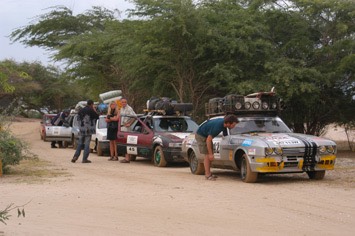
Thursday, 08/01/2004: Trip from Zebrabar into St Louis and back, 50 km
After much postponing of this task, we spent all morning doing our laundry, endlessly boiling the Kelly-kettle to supply hot water. After being through the Sahara, we also eventually dug all the sand out of the tent (It must have been at least one dune!). We drove into St Louis in the afternoon to change money, check our email and do some shopping. There is interesting old French colonial architecture – the river crossing into the town is via an old iron bridge originally made for the Danube. On the pavement outside a restaurant we found a large whale skull – it is unbelievable how and where we always stumble over these things! On the way back to Zebrabar we stopped for a walk at the reserve Guembeul where the endangered scimitar-horned oryx and dama gazelles are being bred in the large fenced reserve. Furthermore, we saw our first wild monkeys of the trip – red Patas monkeys.
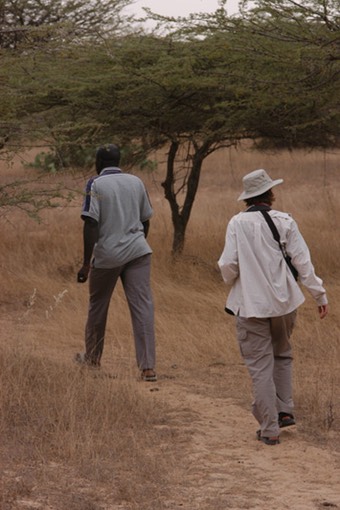
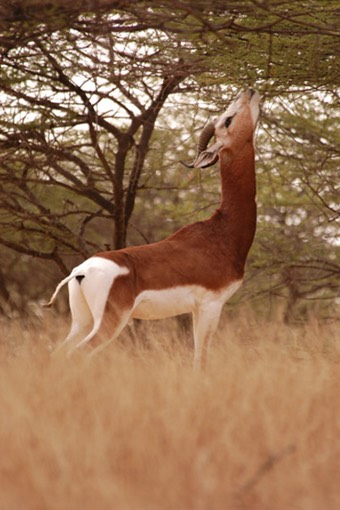
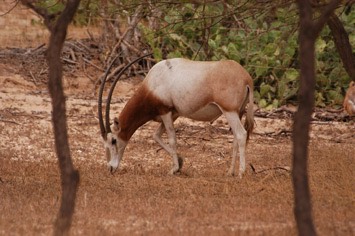
Friday, 09/01/2004: Zebrabar – Djoudj National Park, 71 km
After a short walk to photograph thick-knees and getting our first view of a spectacular red, black and yellow gonolek, we set of for the Djoudj National Park. The tide across the river from Zebrabar was high, so we walked through the ford to test its depth. We then strted Scottie, but the car's starter jammed! We managed to get it released and crossed the ford without further problems. The lagoons south of St Louis held huge numbers of white-faced whistling ducks. North of St Louis the road ran through some nice dry bush country. We saw a magnificent Arabian bustard right next to the piste and a huge monitor lizard at least 1½ m long, as well as more warthogs and Patas monkeys. We passed a beautiful reed-fringed lily pond with jacanas, black crakes, squacco herons and little bee-eaters. When we arrived at the entrance to Djoudj the starter jammed again, but this time we could not release it. After much tapping with hammers and rocking the car back and forth in gear, it seemed the only solution was to take the starter motor off. Soon we had twelve pairs of helping hands – really nice guys who were particularly keen to see the car get fixed as we had broken down in the middle of their football pitch. However, despite taking the offending part off and releasing it several times, the starter kept jamming, so we decided to take it back into St Louis the next day to get it fixed.
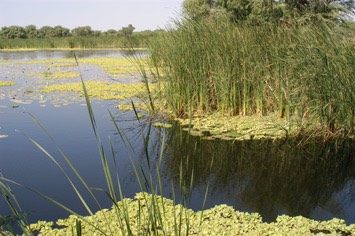
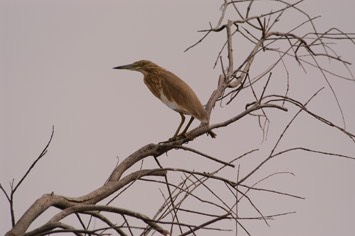
Saturday, 10/01/2004: Trip from Djoudj National Park into St Louis and
back, 112 km
We shared the campsite with a party of French school children from Dakar, who were up at dawn like us. Their truck driver had offered to take us to a mechanic in St Louis, whom he recommended as the best in town. We followed his truck, but at a stop half way the starter jammed again, so we took it off, bump started Scottie and continued on into to St Louis. The mechanic had an outdoor workshop consisting of a small workbench beside a large pile of old tyres, with a couple of sacks rigged up to provide some shade. He and three or four assistants sat on wooden benches and sipped tea while busily working on dismantled engine parts. The surroundings were teeming with activity – this was obviously an area that serviced the old Mercedes vans that had been converted into buses. Our man rapidly stripped down the starter and identified the problem, then drove off to buy super-glue and braze new metal onto the pitted and worn contacts that had been sticking. Soon he returned and after much filing and hammering had forged the refurbished contacts into shape. In less than two hours and at a cost of £20 the starter worked perfectly and we were back on the road to Djoudj again. On the way back we saw more warthogs and Maren’s first African fish eagle.
Sunday, 11/01/2004: Drive through Djoudj National Park, 88 km
One of the guys at the hotel where we camped told us that we could easily walk into the National Park, so we had a bit of a mad dash in the morning when we discovered that we actually had to take the car in, as the distances were far too great for walking! During the morning, we drove along all the available pistes and went into all accessible hides (One of the hides was actually occupied by an owl and another one by a swarm of bees!), but none of these gave good views of birds. So, despite the obvious excellence of the site, the lack of access and information made it very difficult to see many birds at close quarters. However, we saw several jackals (including one with an injured back left leg) and lots of warthogs. Birds included black-shouldered kite, a huge flock of pintails, purple herons and blue-cheeked bee-eaters. On a fairly easy bit of piste, Maren had her first go at driving Scottie – that meant being behind the wheel of a car again after nearly eight years! As we’ve done the pistes, we decided to go on a pirogue trip in the afternoon. While we were waiting for the heat to cool down a bit, we watched two medium-sized monitor lizards, one of which caught a huge frog and struggled for ages to swallow it, but eventually managed to eat it. The boat trip lasted about 90 minutes and was very good value at about five Euro per person. We saw huge numbers of whistling ducks, cormorants and darters and also ospreys, fish eagles, night herons, terns and African and European marsh harriers. The highlight of the trip was the huge pelican colony with thousands of pelican adults and chicks. We also saw our first biggish crocodile!
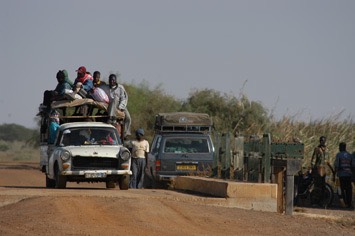
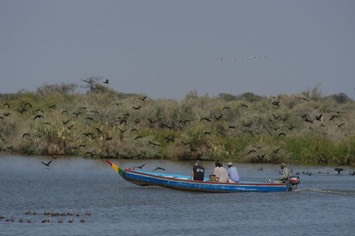
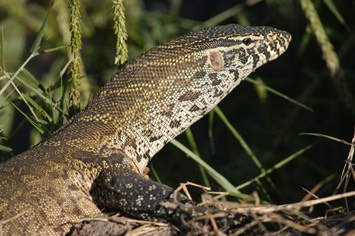
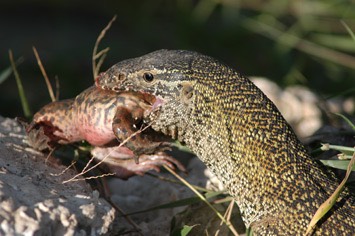
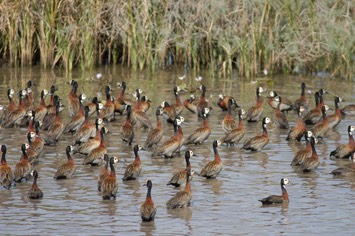
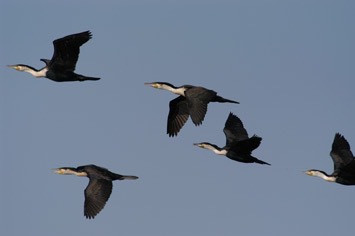
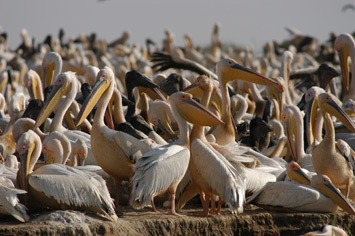
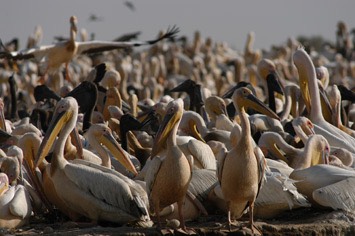
Monday, 12/01/2003: Djoudj – Rufisque, 268 km
On the way towards St Louis we saw more of the always-present warthogs and a Montague’s harrier. South of St Louis, the countryside consisted of rolling hills with lots of baobabs and later palm trees. We started to see vultures and rufous-crowned rollers. On a roadside carcass we saw lappet-faced and white-backed vultures and an immature Egyptian vulture. On the way south, we drove through several small towns with lots of fruit and baskets on sale next to the road. At one of the checkpoints, the policeman asked Maren out – the biggest cadeaux request yet – but we turned him down like all the others before. Near Dakar, it became heavily populated, very industrial, grey and dirty. Hippocamp, the campsite in Rufisque near Dakar we aimed for, is located in a rather shabby area with much development going on. It was a real disappointment, as we hoped to chill out there for a day or two! Before settling down for the evening, we went for a walk on the dirty beach and then spent the rest of the day reading and catching up on the journal.
Tuesday, 13/01/2004: Rufisque – somewhere near Kaffrine in the bush, 235 km
After leaving Rufisque we stopped at Bandia Reserve, where they keep a lot of African mammals in a private reserve, although many of the species are not really native to West Africa but are imported from South Africa. We thought that we could just spend most of the day driving through the reserve, photographing the animals, but were told that a guide was obligatory. However, it turned out to be not as bad as we thought, as the area was densely vegetated and the animals difficult to spot. The rangers were in constant radio contact with each other, so they knew exactly where to find the animals. This way we saw giraffes, roan antelopes, kobs, impalas, elan antelopes, buffaloes, white rhinos and crocodiles. Our ranger also made sure that we had enough time to take pictures and were happy with the results before carrying on. Still, we are looking forward to our first real Safari, where the animals are truly wild! So, after this little excursion, we started heading east, aiming for the Niokolo Koba National Park. The road was either full of potholes or we had to go on detours because of road works, so we only made it about half-way down to Niokolo Koba. So we just hopped off the road at a little piste and went into the bush, where we set up camp near some ancient baobab trees. We also saw more new birds, like the swallow-tailed kites, African grey hornbills and crowned plovers.
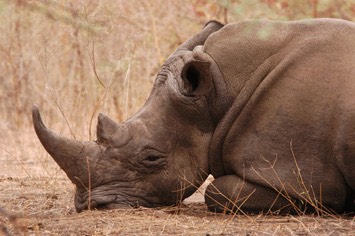
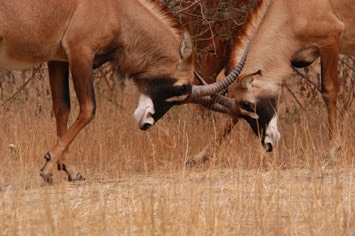
Wednesday, 14/01/2004: Kaffrine – Lion Camp, Simenti, Niokolo Koba, 291 km
We woke up to meet several visitors to the camp; people walking to and from a small village nearby stopped to gaze at the car with a little house on top. The road to Tambacounda was badly pot-holed so progress was slow at first, and the bank was closed for lunch when we arrived at the small town on a key road junction. But there was a good internet booth and plenty of fruit to buy while we waited to change money. Finally, we arrived at the Dar Salaam gate to Niokolo Koba National Park around 5pm to learn that a guide was obligatory while driving around in the park. Tricky, since we have only two seats in the car. But our appointed guide happily climbed onto the roof, where he was joined by one of the staff from the Simenti Hotel who needed a lift in to work. On the long piste into Simenti we saw a herd of roan antelopes, some kobs, bush-bucks, duikers, baboons and a pair of huge ground hornbills. But it was immediately obvious that the dense bush would make it very difficult to see much of the area’s wildlife. A pickup full of armed National Park rangers protested (mainly to our guide) that we were driving later than regulations permit – but nevertheless told us to drive very slowly along the last few kilometres in the fading light to Lion Camp – a small collection of huts on the banks of the river Gambia. There were two Japanese guys there – driver and co-driver of a Toyota in the Paris-Dakar rally – one had ordered dinner but had some stomach upset, so he gave us his plate of chicken and spaghetti.
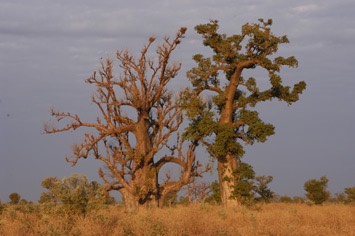
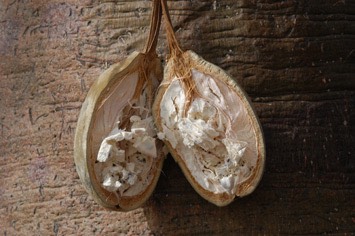
Thursday, 15/01/2004: Bush drives in Simenti area, 53 km
We started our first drive at 7am. Having our guide on the roof seemed to work quite well, as we slowly made our way on narrow winding pistes through dense mixed woodland with patches of an impenetrable looking understory of bushes, creepers and very tall grass. We first checked out a hippo pool a short distance from the camp – there were a few distant heads visible on the surface – and then came across a few waterbuck and quite frequent sightings of kobs and bushbucks. We saw a few roans, but they seemed quite nervous and ran off immediately. A pair of side-striped jackals went about their business in a relatively open area, but most animals here seem very difficult to view and are almost always seen through a veil of branches and leaves. There were lots of striped ground squirrels, baboons and green monkeys. After a long lunch break, we had an evening drive along the river. At a ranger station they have two caged leopards – hand-reared orphans that cannot be returned to the wild. The size difference between male and female was very striking, and also she rolled against the wire to be tickled, while he stood aloof and made hungry-sounding noises at approaching rangers. We also had good views of Egyptian plovers (alas, ignoring the large crocodiles nearby), grey kestrel, shikra, fish eagle, red-throated bee-eaters, gonoleks, blue-bellied rollers, giant kingfishers, grey-headed kingfisher, wattled plovers, rock partridges, drongos,… Back at camp, an almost identical Landcruiser turned up, with a young Dutch family returning from working in Mali.
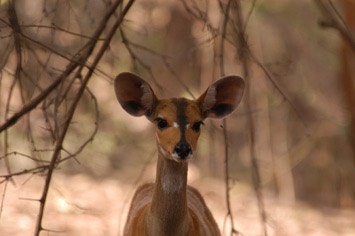
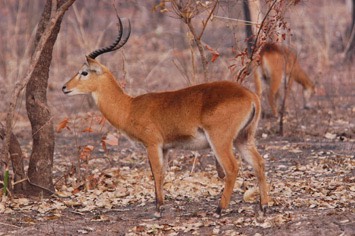
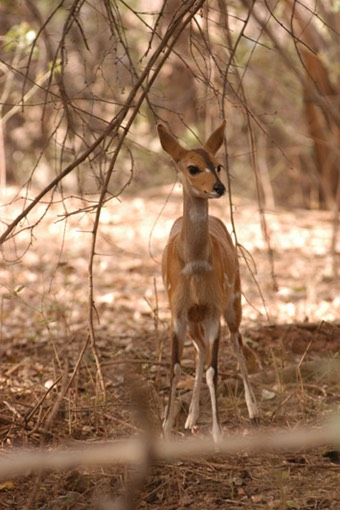
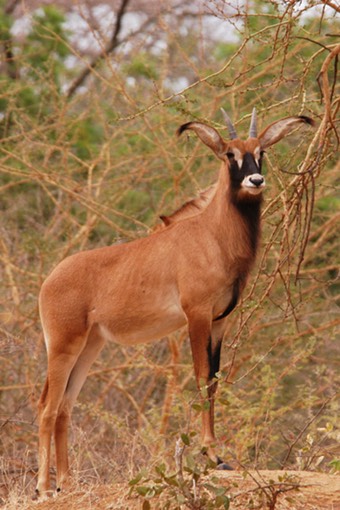
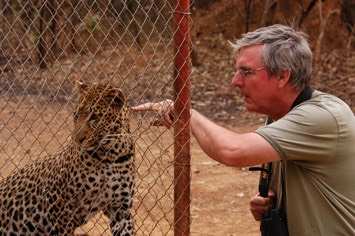
Friday, 16/01/2004: Bush drives in Simenti area, 77 km
We followed the river Gambia to the Grand Mirador – a look-out perched on the edge of the high cliff overlooking a bend in the river. We saw a few kobs, baboons and a fleeing troop of banded mongooses on the way, and had some spectacular views of the river. Two huge monitor lizards were lying on the riverbank – one was a real monster. Also there were some quite big crocs. Mick tried fishing – spinning – but no luck. It seems small live frogs are the bait to use here… - so back to bird watching! More Egyptian plovers and parakeets screeching overhead. Best birds were on a short evening drive when we saw a handsome male red-footed falcon and a huge spotted eagle owl.
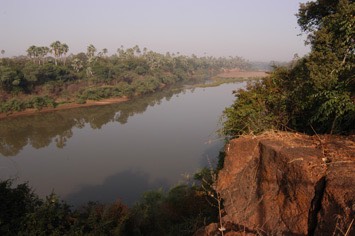
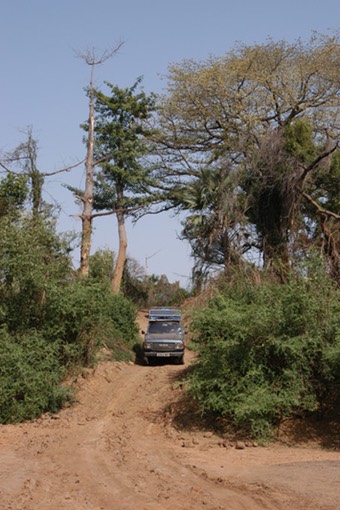
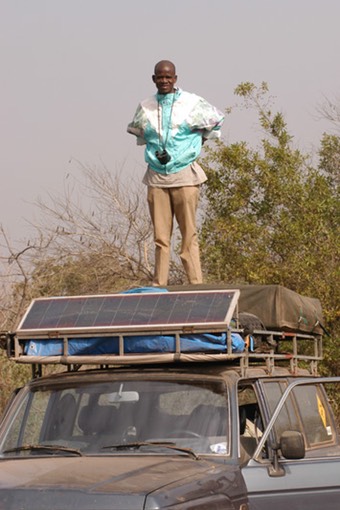
Saturday, 17/01/2004: Simenti – Kedougou, 188 km
We took a long drive on new pistes to arrive at Dar Salaam around 1pm. We didn’t see many mammals but got a really good impression of the diversity of habitats in the area. We went through large thickets of bamboo, tall riverine forests with deep ravines cut by tributaries of the main river, open swamp lands, and a predominantly dry mixed woodland of palms, acacias and a bewildering variety of trees and bushes. But there were many burnt areas at various stages of re-growth and lots of fires actually burning. In some places we could see great palls of smoke rising up on a broad front, suggesting quite big bush fires, but all along the pistes in the Simenti area there were small fires burning. Our guide said these had been set deliberately, to open up the habitat and make it easier to see the animals. However, we made nearly all our mammal sightings in areas of natural-looking bush and saw very little animal activity in the impoverished-looking habitats of the burnt areas. The scale of the burning looks rather alarming. We paid our guide, bought a T-shirt and some postcards from the little visitor centre at the gate, and continued on down the main road from Tambacounda to Kedougou, which runs right through the National Park. We saw a dead civet on the road, which was presumably run over last night and another, older road killed civet later. We stopped at Niokolo Koba itself, which was nothing more than a bridge over the river. We were a bit disappointed to find there were no open pistes there and access by car and on foot was not permitted. So we drove on to Kedougou and found the Hippo Safari Lodge on a quiet bend of the Gambia river. On arrival we were greeted by the sight of three hippos and a party of French hunters. Sounds of gunfire as they beat through the tall grass.
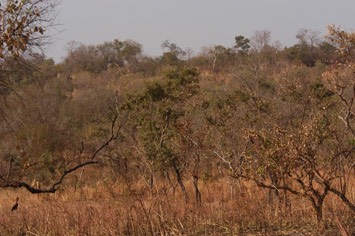
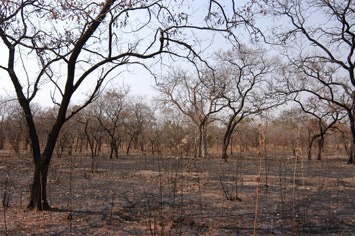
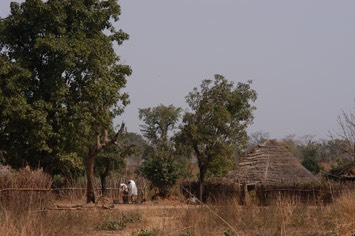
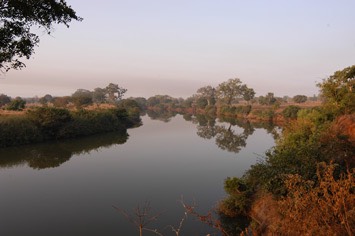
Sunday, 18/01/2004: Stationary at Hippo Lodge Safari, Kedougou
We took a day off with gentle walks to see gabar goshawk, violet turacos, red-rumped swallows nesting in the bar, large flock of house martins on the river, cackling parties of wood hoopoes and plantain-eaters. In the evening, we had Francolin for supper – presumably shot by the French hunters!
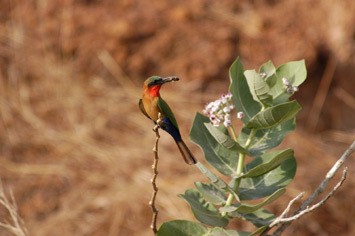
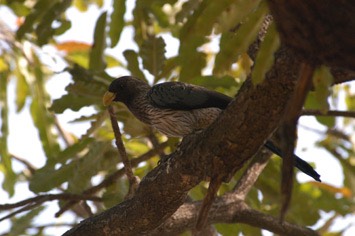
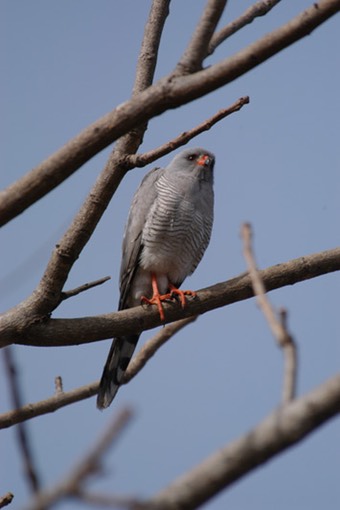

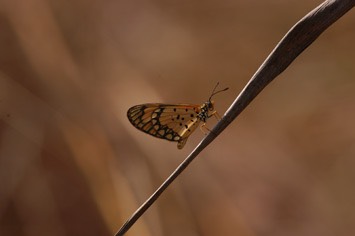
Monday, 19/01/2004: Hippo Lodge Safari – Mako Safari Lodge, near
Kedougou, 38 km
While we were getting ready for departure, Maren started to feel unwell with an upset stomach (We decided to blame it on the salad or fruit we had last night in the restaurant). We stopped in Kedougou, a thriving little market town, for phone calls, fuel and peanuts. A pick-up with dead warthog stretched across the back passed us and we came across check points for the enforcement of hunting regulations. Maren was still not feeling too good, so after clearing the town on the road heading back into Niokolo Koba, we pulled in at another French hunting lodge at Mako, where we could take a hut with bedroom, shower and toilet. The lodge is set in dense bush on the banks of the river – full of birds and five hippos on view near the lodge.
Tuesday, 20/01/2004: Stationary at Mako Safari Lodge, near Kedougou
Maren was still feeling pretty low but has not got too serious a problem (Fortunately!). So we decided to just stay and have a lazy day by the pool-side. Mick discovered the hunting tax for killing your first warthog is 30 Euro, 35 Euro for the second warthog, up to 600 Euro for a buffalo, the most expensive animal on the list. Shooting lions is not permitted this year…
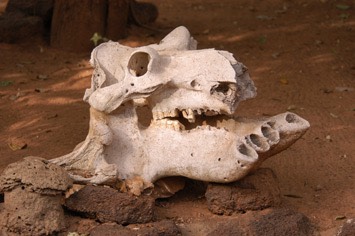
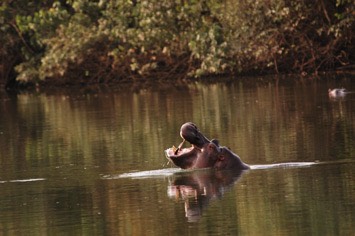
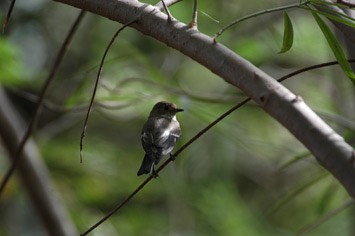
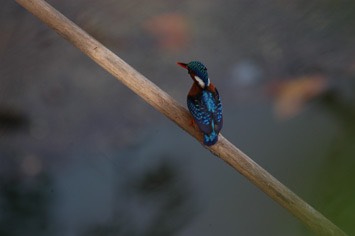
Wednesday, 21/01/2004: Mako Safari Lodge – Bird Safari Camp,
Georgetown, 346 km
Our guide at Simenti told us that, although there certainly were lions in the National Park, they were almost impossible to see. We met an American VSO at Dar Salaam who showed us a photo of a lioness and her cubs taken by one of the other volunteers beside the main road to Kedougou, but sightings were said to be extremely rare. Having driven down the Tambacounda – Kedougou road already, we conceived the idea of driving back up it through the National Park in the dark. Driving at night is something we have completely avoided, but this was a newly surfaced road with no potholes, no villages so no donkey and bicycle traffic, and a very low density of long-distance traffic. When the alarm went off at 4 am we found ourselves covered in bed bug bites. Yuk! So much for expensive French run hunting lodges. Pulled out onto the moonless road at 4:45 and we straight away started seeing small creatures of the night. First a small jumping rodent, then a nightjar in the road and large owls. Then the first good view of a mammal – a genet that sat mesmerised by our powerful lamp long enough to take some photos. We saw three or four genets in all. We continued driving on up the middle of the road very slowly with the windows open. Suddenly a leopard dashed across the road in front of us, then circled around in tall grass from which its head peered out as it stared straight at us. It circled around to look at us from a couple of different places, but always stayed behind dense cover. Carrying on and now around half way between Niokolo Koba bridge and Dar Salaam, we suddenly came alongside two lions standing right next to the road! We stopped and gazed with amazement at these big, slow moving animals, as they walked past us and along the road in the other direction. That left us desperately trying to take pictures out of either window while doing a slow 3-point turn to face the animals as they mounted the tarmac and walked casually away down the road. We left them to their business, turned the car back around and drove on, babbling excitedly about our close encounter with the king of the beasts. They did not have well developed manes but from the photos you can see they were males. A duiker and a warthog was all we saw before the dawn came up, when we stopped at a river bridge where baboons were still high in the trees and a gonolek came out in the open to sing and be photographed. It was still early by the time we neared Tambacounda, where we turned off on the road leading to a crossing point into the Gambia. On the way, we passed a dead serval cat in the road. The border crossing was very easy, took less than half an hour and cost only £1, although that turned out to be a spurious fine for crossing the border outside normal office hours (which we didn’t). We went into Basse to get visas and then drove on down to Georgetown, via a ferry crossing onto McCarthy’s Island, and so to the Bird Safari Camp. It was a long day, but one of the best of the trip.
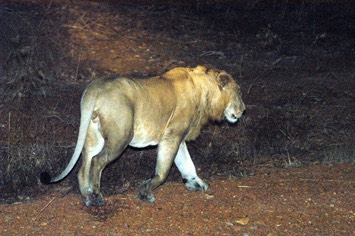
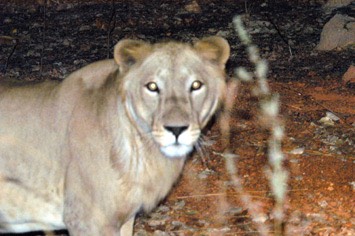
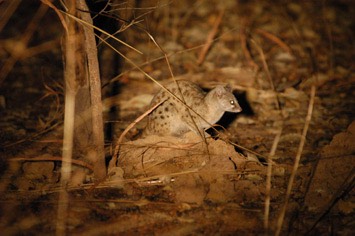
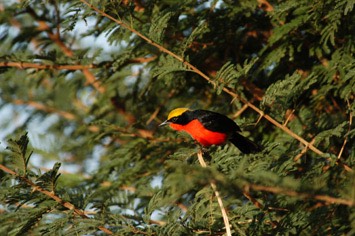
Thursday, 22/01/2004: Stationary at Bird Safari Camp, Georgetown
We walked to the end of the island in the morning, where we saw lots of parakeets and Senegal parrots. We took a long boat trip in the evening in search of elusive hippos, but saw many birds, including many different herons, palm nut vulture and monkeys, including the red colobus. Maren was somewhat exhausted after some sunburn and three hours in the boat. It is very hot here.
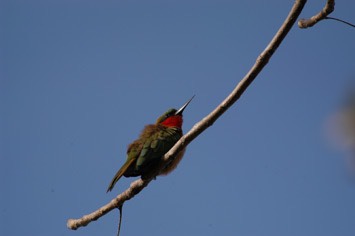
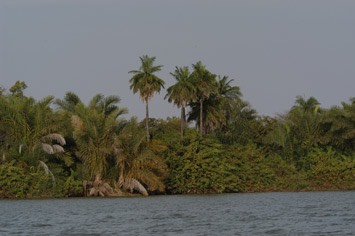
Friday, 23/01/2004: Georgetown to Boboi Beach Lodge, near Kartong,
269 km
We drove down to the coast from Georgetown on the worst road we have encountered so far. We saw a chameleon on the road, which we rescued before it was run over by a car and a 1 m long green snake, which we nearly ran over, but managed to miss by a few centimetres! Very badly potholed tarmac meant constant bumps and much of the time driving with at least two wheels off the road on the side. We came across two guys in a hired Toyota 4x4 from which a front wheel had come off. Scottie survived the beating, but after this eight hour hammering, Maren was totally wiped out when we arrived at Boboi Beach Lodge near Kartong, a camp at the southern end of the Gambian coast, at 18:15.
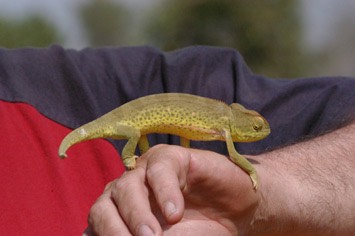
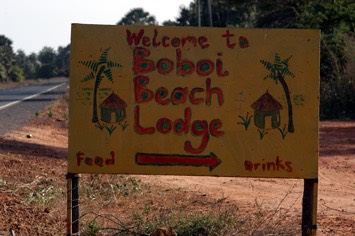
Saturday, 24/01/2004 – Sunday, 01/02/2004: Stationary at Boboi Beach Lodge, Kartong
We took a ten-day holiday on the beach – mainly doing nothing, relaxing, and surfing on body boards. We went into Kartong twice, the first time to use a telephone and the second time to visit the sacred crocodile pool. On the first occasion we met a young boy of around twelve years who busily tried to engage us in a conversation and offer us his services as a guide. It was nearly impossible to get rid of him, as he kept trailing behind us. In the end he got pretty nasty, as we didn’t want to give him any money for all his “services”. That was definitely our worst hustling experience so far! When we went to the crocodile pool, we first met another hustler, although he was fairly low-key, and then met up with the young boy again! Great! Fortunately, they left us alone for quite some time, so that we could watch the crocodiles and the birds around the pool. Then the boy came back, trying to engage us in conversation again. We were fairly mono-syllabic – but it didn’t work. When we left, he started demanding money again and, when we didn’t give him any, he told us that he had a knife and that he would stone us!!! Mick then threatened to take him to his father and we walked into the village, which eventually sent this boy running. However, it was a really bad experience, which left us feeling slightly wobbly and rather jumpy whenever somebody approached us. We also visited a nearby reptile farm, which is run by a French guy. It is set in a nice bit of bush, and he suggested that like-minded people should buy some land to protect it from the recent development going on there. He had some snakes in pits, including a royal python he draped around Maren’s neck and two mean-looking puff adders – which we didn’t let anywhere near us! – as well as lizards, chameleons and terrapins. Boboi is a great place to relax – we put our tent up in the shade of palm trees, everybody was extremely friendly and cool and they had the sweetest dog there we have met on this trip. We, basically, adopted “Simba” after a few days and took her for long walks along the beach in the evening. Leaving her behind felt really weird, as she was such a good companion. The water temperature of the sea was really nice, and going for swims and surfing was a welcome break from the heat of the day.
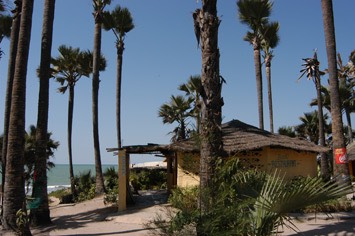
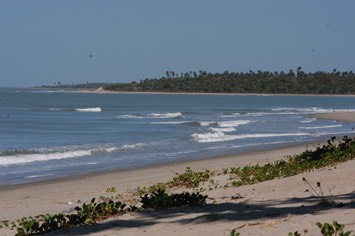
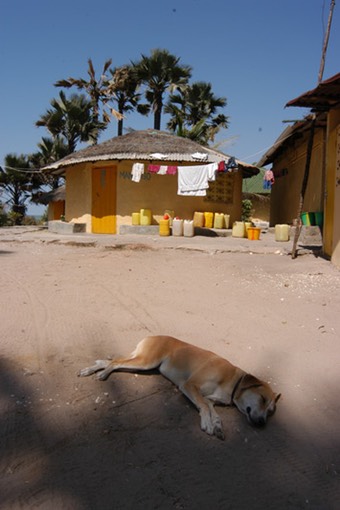
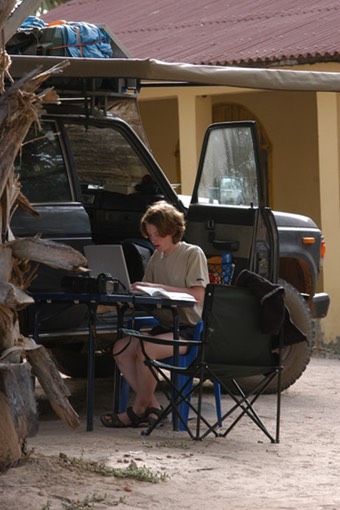
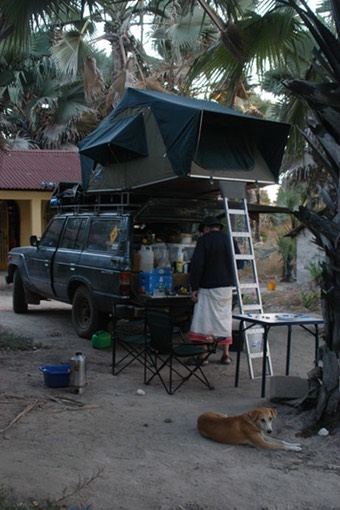
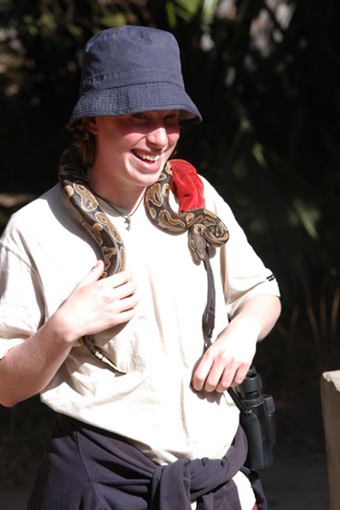
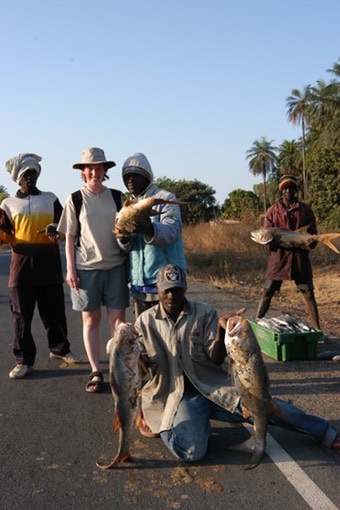
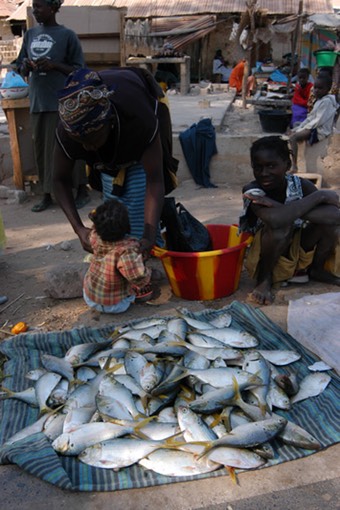
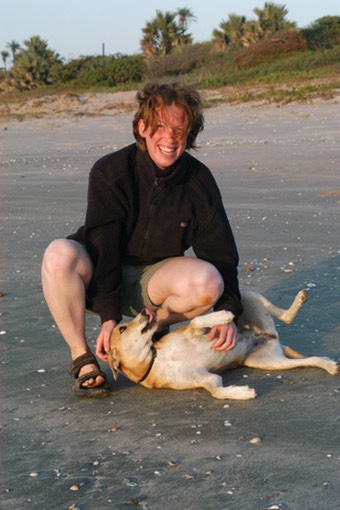
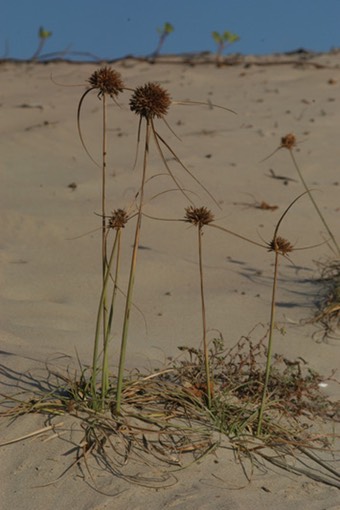
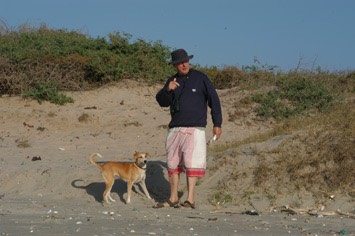
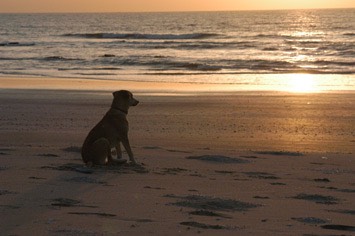
Monday, 02/02/2004: Boboi Beach Lodge – Sukuta, 81 km
After ten relaxing days on the beach and many good-byes from the guys working at Boboi (except good old Simba, who was elusive), we were on the road again! We drove through the tourist area around Kololi and Bakau and had our lunch on the beach at Cape Point. We then carried on to Banjul, the capital of the Gambia, where we had to make lots of detours, as there is a fantastic arc on the road – but only the president is allowed to drive through it! There wasn’t much activity due to the bank holiday after Tabaski. We found Camping Sukuta, which is run by a German couple, which also attracted stacks of German overlanders.
Tuesday, 03/02/2004: Drives in the Sukuta area, 51 km
After leaving Boboi and making for Sukuta Camping not far from Banjul, we discovered that one of the car’s rear springs was broken, presumably on the really bad road from Georgetown. We tried to get it fixed but it was still too close to Tabaski and many workers had still not returned after the holiday. We had a first look around Abuko Nature Reserve, seeing red colobus, green monkeys and many birds, best of which was Vereaux’ eagle owl. We went on to Lamin Lodge to organise a dolphin watching boat trip. The lodge is a fantastic wooden construction built on stilts over the mangroves at the edge of the water. The German owner Peter sailed to the Gambia some 20 years ago in a small yacht bought in Menai, Wales. There were lots of green monkeys everywhere, trying to steal food from the tables. On the way back to Sukuta we called in at the Department of Parks and Wildlife Management, where we met Linda Barnett and Craig and made an appointment to meet them for longer on Friday afternoon.
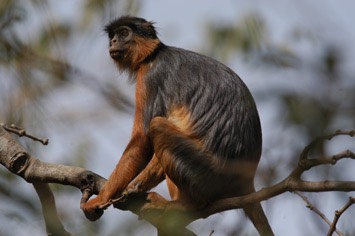
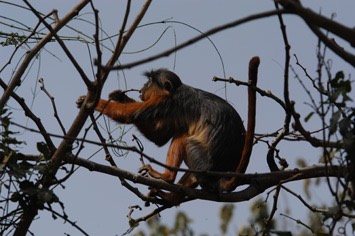
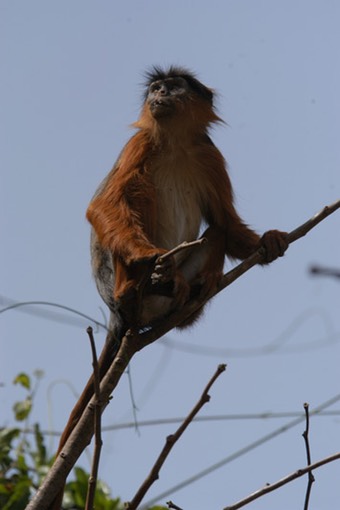
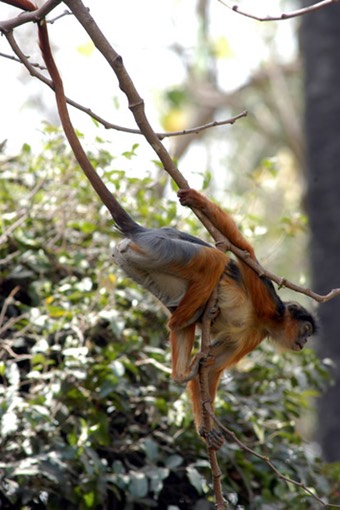
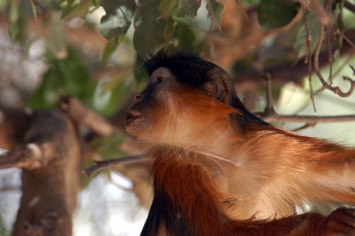
Wednesday, 04/02/2004: Sukuta – Serekunda, 15 km
We drove into Serekunda to meet Moussa Top for the spring repair. His spring man went off and found a suitable spring, dismantled it and extracted a leaf to replace our broken one. The replacement was a bit too long, so he heated it up in a charcoal forge, cut the end off and then hammered it around a metal tube to form the required shape on the end. After much heating and hammering, the spring was re-assembled and fitted - some three or four hours later. The cost was 1800 Dalasies (about 50 Euro). While we were waiting and watching, we got covered in a thick layer of black dust, so the showers back at Sukuta were very welcome to wash it off.
Thursday, 05/02/2004: Drives around the Sukuta area, 42 km
We set off for Lamin Lodge at 7:25 in convoy with Christine and Sven from Hamburg (driving a rusty HJ60 they plan to sell down here) for a dolphin watching boat trip. However, the Harmattan was blowing, the air was full of dust and the sea was very choppy when at last we reached the open water of the Gambia river near Banjul, having waited an hour for the boatman to turn up. An additional crewman was taken to bale out continuously, as the planks leaked and we shipped quite a bit of water in the choppy seas. So we turned back early, being quite soaked. We came back through the mangroves, but there was not much bird life to see. Peter, the owner, was a little cross with his manager for letting us go out in such poor conditions, so he gave us a part refund and treated us to a free lunch!
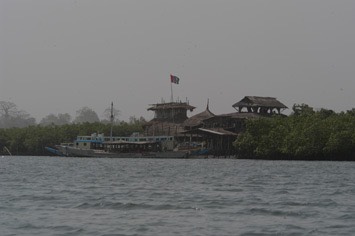
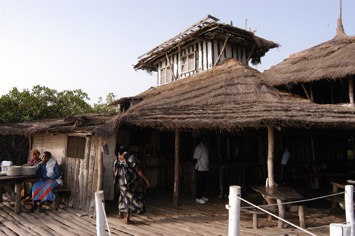
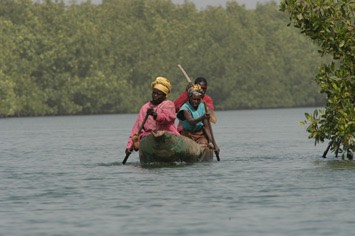
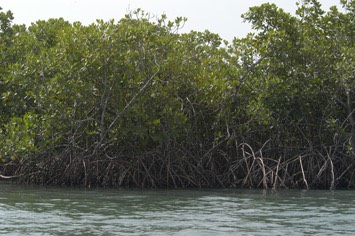
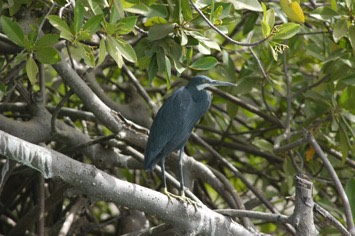
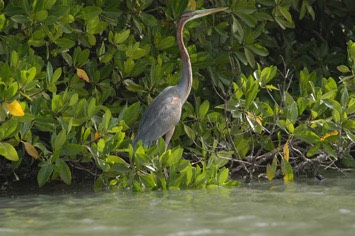
Friday, 06/02/2004: Sukuta – Boboi Beach Lodge, 78 km
We had breakfast with Christine and Sven before setting off for Abuko. We enjoyed an excellent walk, exploring every path in this small forest reserve, filling our camera memory cards for the first time (i.e. 2 Gigabytes). There is an animal orphanage there, some of which is a bit sad (especially monkeys and parrots in cages), but a family of spotted hyenas was particularly interesting. Right at the end of our visit we discovered a hide overlooking a pool where we took many photos of bushbucks, duiker and green monkeys. We were running a bit late for our meeting with Linda, but when we arrived we discovered that she had forgotten all about us and was just about to have her siesta! However, we had a fascinating discussion about the region, its wildlife and conservation issues. Linda advised us to go to Ginak island to see hump-backed dolphins and gave us contacts to set that up. Then we drove down to Tanji but failed to find a good place to stay, so we ended up driving back to our favourite camp site at Boboi, where we were met with big smiles like long lost friends.
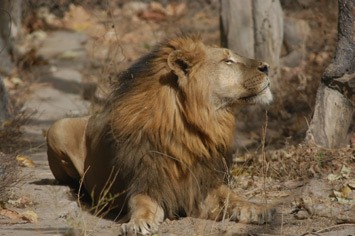
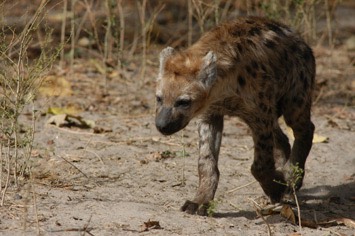
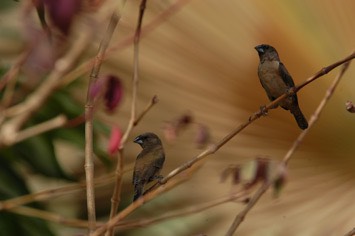
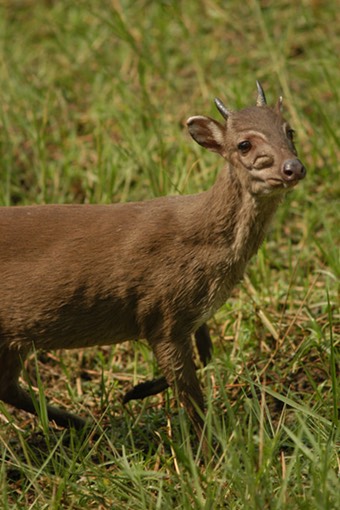
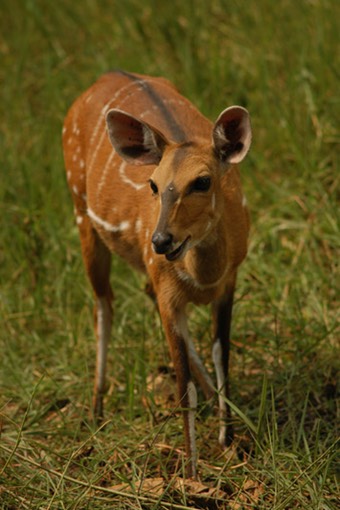
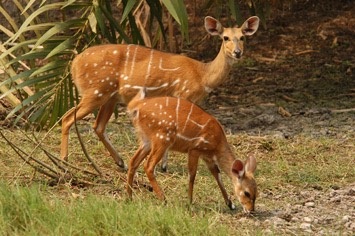
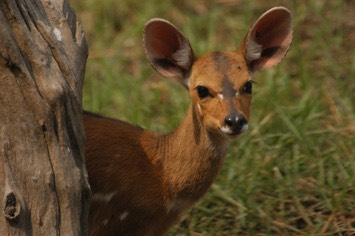
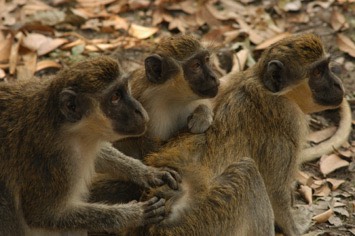
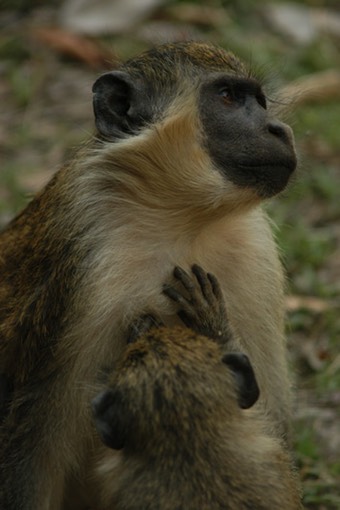
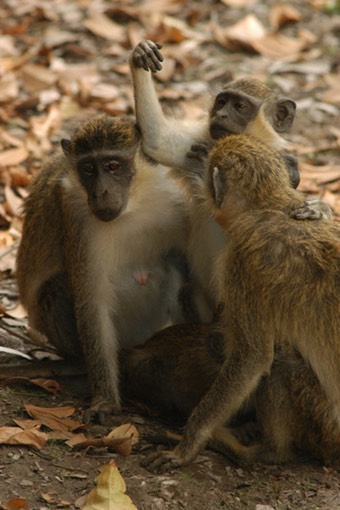
Saturday, 07/02/2004: Stationary at Boboi Beach Lodge
We went for a little walk following baboons up the road and had a good surfing session in the afternoon, but otherwise spent a very lazy day. On our walk in the evening we found part of a dolphin skull on the beach. Many people have arrived for the weekend and the place is full to bursting. Due to the heavy use of the shower/eco-toilet, a little pond and its associated wildlife has developed there and in the darkness Maren stepped on a frog.
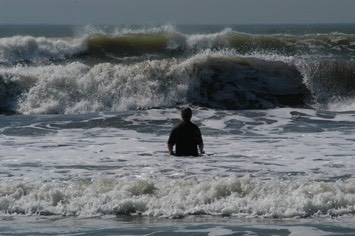

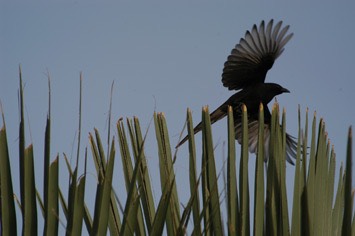
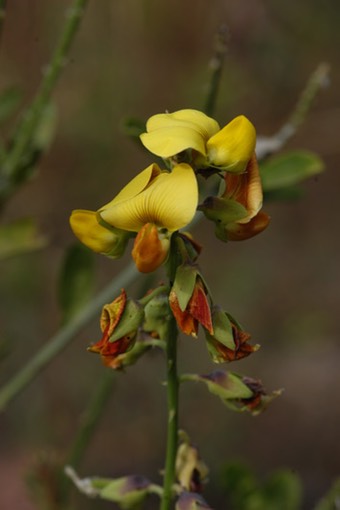
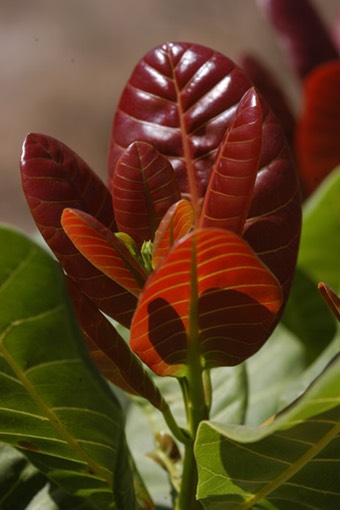
Sunday, 08/02/2004: Stationary at Boboi Beach Lodge
We had another lazy day, short walks, surfing and then into the village to make phone calls. We got hold of the guy running the hotel on Ginak island and he told us that he was watching dolphins as we were talking to him! That sounds encouraging! So we tried to set up to go over on Tuesday.
Monday, 09/02/2004: Boboi Beach Lodge – Sukuta, 52 km
We updated the computer journal in the morning and then said our goodbyes again and drove on to Kololi. There we had pizza for lunch (yammie!). The internet was hopelessly slow – Mick managed to read two messages in 45 minutes, while Maren couldn’t even access her mailbox! Frustrated, we tried the internet café on Pipeline Road, which was still slow, but at least we managed to read all our important messages. We went back to Sukuta, where we had dinner with Christine, Sven and the guy from Saarbruecken and then spent the night in one of the huts, which had a big, comfy double bed.
Tuesday, 10/02/2004: Sukuta – Ginak Island
We got up at 6:30 to be ready for 7:00 when Wolfgang (another German) picked us up at the camp site and drove us to the Banjul ferry terminal. There we joined a group of twelve Brits going to Ginak Island on a day trip. The ferry was rather small and couldn't hold many cars or lorries at once, so there was a long queue of lorries waiting. When we left Banjul, the ferry was packed full. We found a prime spotting spot at the front of the upper deck, but saw no dolphins during the crossing. When we arrived in Barra on the north side of the river, people started getting off the ferry before it was properly tied up – so much for safety… Outside the port our group boarded two Mark 3 Landrovers and we headed towards Ginak. The cars were pretty funky compared to good old Scottie Landcruiser standards and we bounced around on the open back while driving over potholed roads and sandy pistes. We stopped for banana sandwiches in the bush and then got onto the pirouge, which took us around the northern tip of the island to Madiyana Lodge on the western side. Again, we didn’t see any dolphins. The hut is very nice – we share it which lots of living things like agama lizards and hornets – but unfortunately they don’t have the promised loo! It's a short walk to a separate bathroom building. The buffet lunch was very good and afterwards all the guys from the group disappeared and only one couple from Poole stayed behind with us. In the afternoon we went for a walk along the beach, where we met the guy from Poole proudly carrying a dolphin vertebra (although not knowing what it was) – damn, we wanted to find that! However, we still found some bones: a shoulder blade (?), another vertebra and another turtle bone with marks of a knife on it. Near the northern end of the island we came across a sandbank with a huge gathering of terns: Caspian, Royal, Lesser crested, Sandwich and Little terns as well as Slender-billed gulls. Another couple had arrived while we were gone and we all had dinner with Fodday, the owner. It was a three-course meal: vegetable soup, spaghetti and coconut cake.
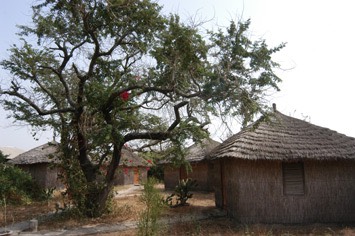
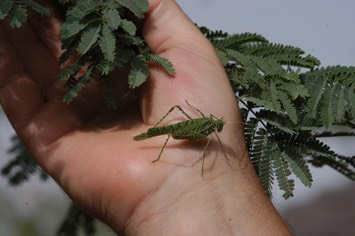
Wednesday, 11/02/2004: Stationary on Ginak Island
We got up early to watch for dolphins and birds and Mick tried some fishing from the jetty, but didn’t catch anything. We didn’t see any dolphins but did see lots of weaverbirds, white-billed buffalo weavers, as well as sunbirds, coucals and gonoleks. On a short walk before breakfast we discovered “our” butterfly – the African Monarch – sitting on a spiky grass full of vicious burrs. Breakfast was very late but also very good. On a short walk through the nearby bush we saw a Patas monkey. After a fantastic lunch of ladyfish – just for the two of us – we walked along the beach to the northern end of the island, which in fact is already in Senegal! We saw lots of birds again, but no dolphins. Dinner was salad, vegetables and rice and pancakes with syrup for dessert. In the evening, they light all the paths around the huts with paraffin lanterns, which gives it a very romantic flair!
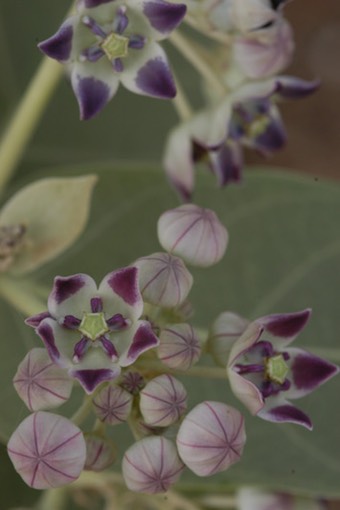

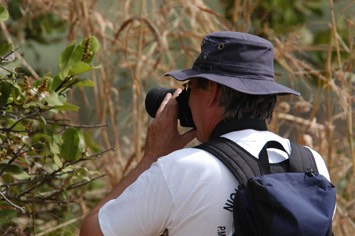
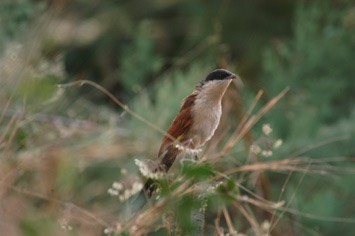
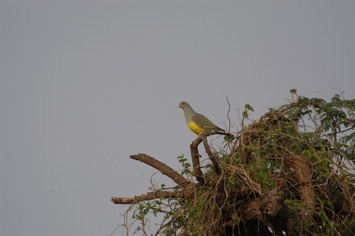
Thursday, 12/02/2004: Stationary on Ginak Island
The early morning watch didn’t yield any dolphins again. After breakfast we walked into the village, where we were soon surrounded by school kids having their mid-morning break. They all wanted to hold our hands and followed us every step. Then one of the teachers invited us to have a look around the school. We met the headmaster in his office; he told us a lot and also very openly asked for a donation to help fund things for the school and support the parents. After looking into all the classrooms and even listening to a song especially performed for us, we headed back towards the lodge. On the way into the village we had passed many plantations of cannabis. It seems this is the only crop grown here – quite openly – relying on black magic for protection, as a curse is said to befall any state official crossing to the island with intent to harm the activities of the islanders. At least, that’s what they say. So walking out, we called in for a guided tour of a ganja farm. Ripe flower heads were laid out in thick carpets to dry. The compound was all cultivated, except for a small drying yard next to the house and a well dug in the sand. A coarse fish meal, really just dried lumps of fish, was used to fertilise the plants. Apparently, farmers get around £8 per kilo. In the afternoon, Maren chased the butterflies to get some decent pictures and Mick relaxed near the sea, which was rather choppy. So again – no dolphins but probably a head of a turtle sticking out of the sea. As we were the only guests left, we had a private paraffin lit dinner of fantastic chicken with potatoes, rice, carrots and juice, followed by chocolate cake! The old guy who cooks these great meals apparently is the first cook of the first hotel in the Gambia. He was very pleased when we praised his food. Just as in Boboi, everybody here is extremely friendly and it is a real shame that there aren’t more guests here!
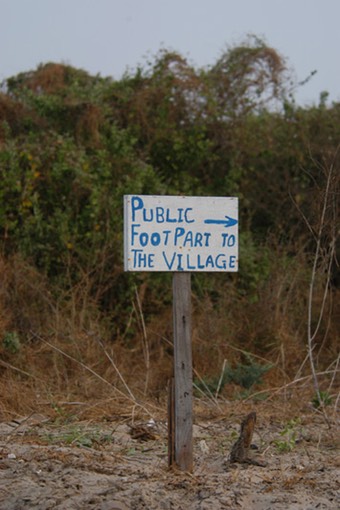
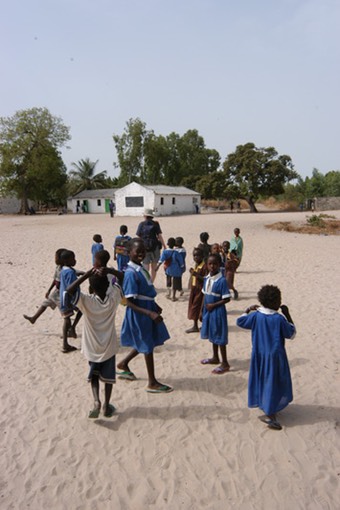
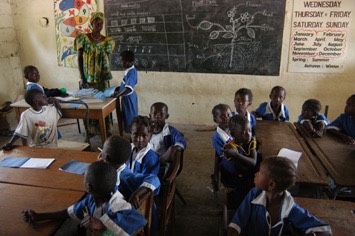
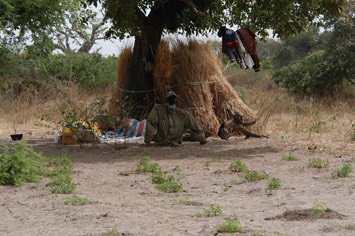
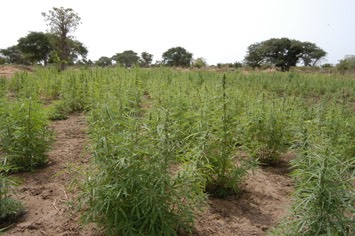
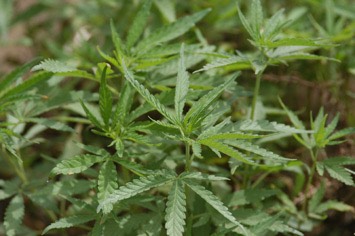
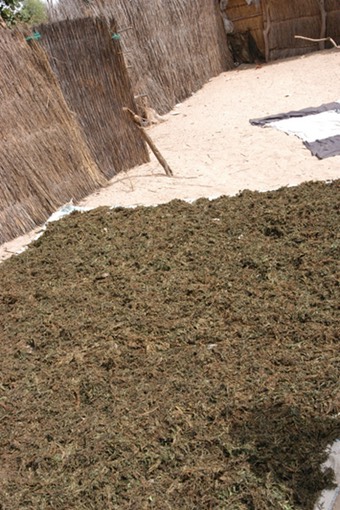
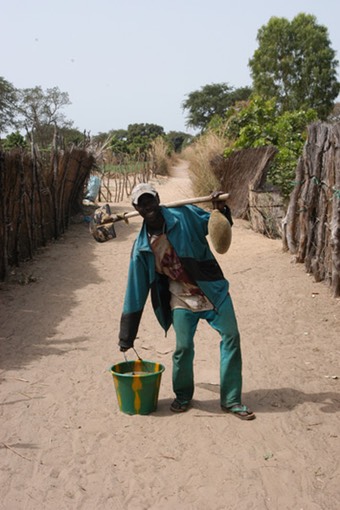
Friday, 13/02/2004 (uh-oh!): Stationary on Ginak Island
Again, no dolphins – but what else to expect on a Friday 13th?. We walked along the beach before breakfast and then back into the bush afterwards. Maren spotted another Patas monkey, but unfortunately it was gone before Mick could see it. On a flame tree we saw two more species of sunbird. In the bush we came across a guy who whistled and shouted at us, and we thought he said “dolphin”, so we raced back to the lodge, just to discover that it was a false alarm. We had buffet lunch with another group of Brits, but none of them stayed. It was overcast but very humid, so we just crashed out on the beach. After a snooze in the shade, we chased some more butterflies and then sat watching the seas go by and stacks of osprey flying around. At night, we found a huge gecko in the toilet – now Maren knows what nearly scared her to death the night before!

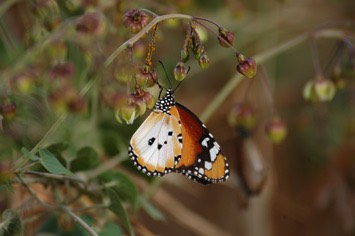
Saturday, 14/02/2004: Ginak Island – Sukuta and drives in the Kololi
area, 25 km
After another morning watch without dolphins, we walked to the sandbank to board the pirogue to Banjul. Sea state 2 and low swell but we only saw a few jumping fish and no dolphins. We landed at the pirogue station and organised a taxi to take us back to Sakuta. During the drive we found out that the taxi driver’s sister lives in Habstedt in Bremen! All the while a terrible radio program filled the taxi with a crazy quiz show based on reciting all the brands of soft drinks made by a certain company. Went to Kololi for supermarket shopping and then on to Bakau where we wanted to buy souvenirs but just ended up with fruit. We stopped at the Commonwealth war cemetery where allied soldiers, sailors and airmen from WWII are buried. Afterwards, Mick had a painful haircut on Pipeline Road. Back at Sukuta we started sorting the car out for out departure north the next day and found loads of mouse shit!!! That explains the large holes in our fruit and vegetables found earlier at Boboi… We took everything out of the car, found lots more evidence of mouse activity but not the mouse itself.
Sunday, 15/02/2004: Sukuta – Missirah, 61 km
We left our comfy bed at 6:30 and drove up to the ferry terminal in Banjul. We missed the next ferry but after getting our tickets organised we caught the following one. The cars were loaded tightly so we could only just squeeze out to climb up to the upper deck. Just before reaching the north bank of the Gambia river we saw two dolphins. Without binoculars we couldn’t identify the species with certainty, but they were probably bottlenose dolphins. Some dolphins at last! We drove up to the Senegal border, which we crossed in record time; no fees to pay and no requests for cadeaux! We drove to the Gite de Bandiala in the south of the Sine-Saloum Delta. They offered no camping there so we only had a cold drink, watched Patas monkeys at their artificial water hole and then carried on to the National Park headquarters near Missirah. We did a guided walk with Kanoute and saw warthogs, a martial eagle carrying off a kill while a squirrel screamed at it, and then four bushbucks, two of them handsome males. We arranged a boat trip to look for dolphins the next day. Hyenas were howling as we went to bed.
Monday, 16/02/2004: Missirah – Bandiala, 7 km
Maren had a troubled night with diarrhoea so we cancelled the boat trip and headed back to the gite for some comfort, taking a hut with ensuite bathroom and loo. Maren was not too bad. We saw three monkey species from out of our window and at the water hole and another martial eagle.
Tuesday, 17/02/2004: Bandiala – Kaolack, 78 km
There was no room for a second night at the gite and the next possibility for a dolphin watching boat trip in the National Park was Thursday, so we drove towards Kaolack, Maren feeling much better. We pulled off the road for a picnic lunch next to the river and drove over salt encrusted mud deep in conversation and oblivious of the danger when the front wheels broke through and bogged down. Yuk! It was extremely hot and we got very exhausted trying to dig the car out. Eventually Mick walked back to the road to get help, as the car was down to its axles in sticky mud. A French motorist called a garage on his mobile phone and, after a long wait, help arrived. After more digging and jacking and the use of sand tracks, we got out. Altogether we had been stuck for four hours. So, covered in mud, we made for the very smart Relais in Kaolack, where we took a room with a dolphin carved on the door. There, we had excellent food and an air conditioned room with TV and a hot shower.
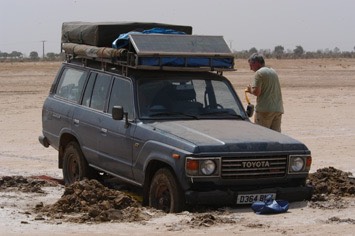
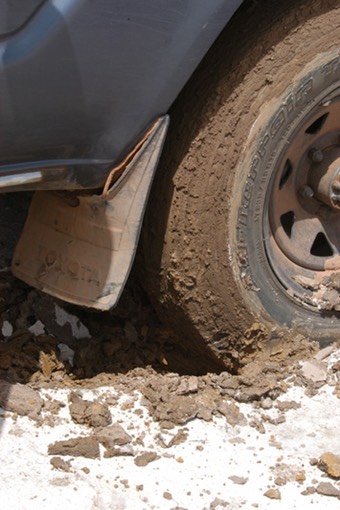
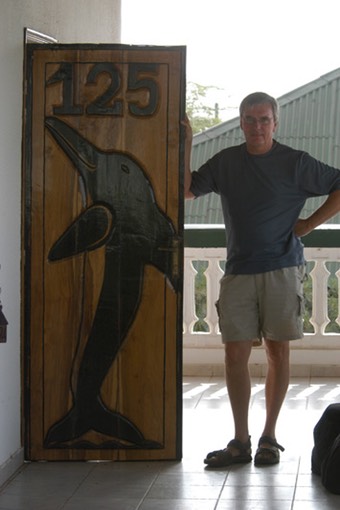
Wednesday, 18/02/2004: Kaolack – Missirah, 79 km
We walked around Kaolack market: apparently it is the second largest covered market in Africa, but nowhere near as interesting as the souk in Marrakech and there was nothing for us to buy. We drove back to the National Park Headquarters in Missirah, where we went for a short walk before starting to organise the boat trip. Mick helped one of the staff with his report writing on a laptop. Warthogs and a large mongoose were scavenging around the rubbish in the compound. Kanoute, the guide, arrived after we had gone to bed.
Thursday, 19/02/2004: Boat trip to the Isle des Oiseaux, 9 km
We got up early and packed the tent away so we could drive into Missirah for the boat, with Maren perched on the centre console to fit Kanoute into the car. We headed out for the open sea and the Isle des Oiseaux, not in a nice traditional pirogue but in a plastic boat. No dolphins to be seen on the way. We walked almost the length of the island, where huge numbers of Caspian terns, slender-billed and grey-headed gulls were gathered, together with little and royal terns and pelicans. The Caspian terns had started nesting, but still let us approach to within a few metres. After a picnic, Kanoute and the boatman disappeared for a three hour siesta. We got a bit bored sitting on the beach not knowing what was going to happen. However, we didn’t want to go far away and, in the end, Maren got sunburnt for the first time on this trip. At low tide many women appeared on the shoreline to collect molluscs. In the afternoon, the boat took us straight back, despite our having been told we would look for dolphins. Kanoute charged us 40000 CFA. The lack of effort looking for dolphins was very disappointing, as we had assumed that this would be the main part of the trip, not having a siesta on the beach! However, the number of birds on the island was definitely worth the trip and we came back with lots of pictures. Soon after arriving back at the camp, we were summoned by the big boss, who was sitting regally under a big tree. A public enquiry ensued, during which we were questioned closely about how much we had paid and what exactly we had paid for. It turned out that Kanoute had used the National Park boat but charged us as though he had arranged a private hire. The end result was a refund of 18000 CFA to us and a one month suspension for the disgraced Kanoute. Later in the evening a teacher from a nearby village arrived on a motorbike without lights, to ask if we could fix a problem on his laptop, which was unfortunately not possible.
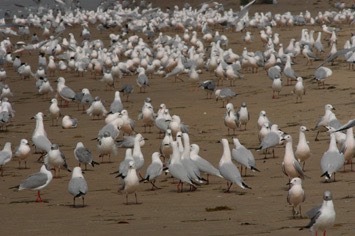
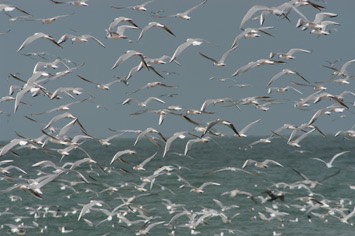
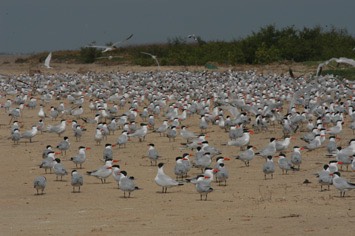
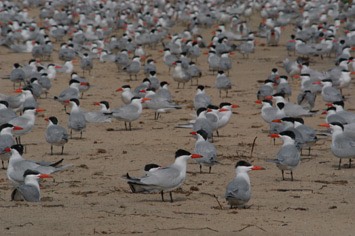
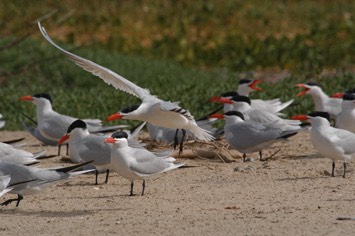
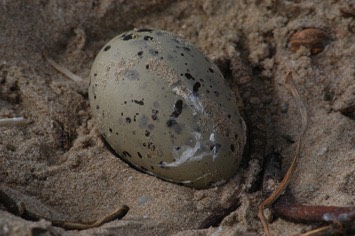
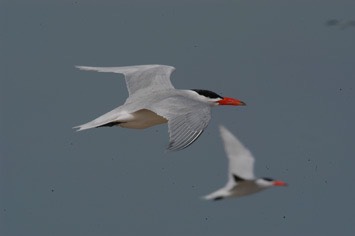
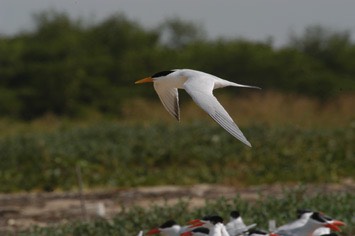
Friday, 20/02/2004: Missirah – Lac Rose, 255 km
We drove via Kaolack to Lac Rose near Dakar – this time without getting stuck in the mud near Kaolack! But this time we had a puncture on a tarmac road just before arriving at our destination. However, with the help of a local boy, the wheel was quickly changed. A condition of camping at Lac Rose was that we ate at the Bonaba restaurant. We shared the meal with an English couple, Elouise and Ben, who were working as volunteers with an environmental NGO in Dakar. We crashed out early after the long drive on poor roads – there were many detours around roadworks in this section.
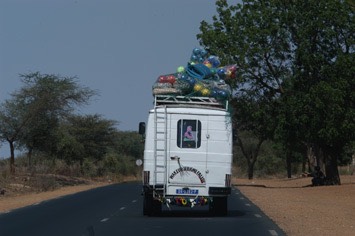
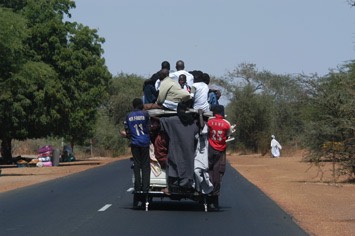
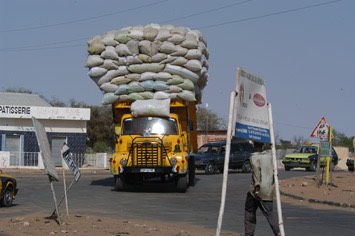
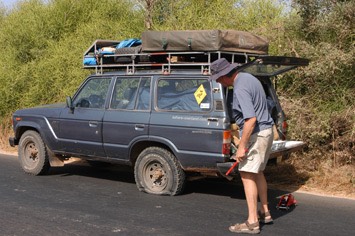
Saturday, 21/02/2004: Lac Rose – Zebrabar, 262 km
Before leaving we photographed the whale vertebrae and dolphin skull decorating the walls of the restaurant. Seeing our interest, we were given the skull! We drove around the shore of Lac Rose, with Ben and Elouise on the roof, where there is a small scale salt gathering industry. The lake really does look pink due to its mineral content. On the way we got the puncture fixed for 1000 CFA (putting our inner tube in) before driving on to a fishing village on the coast. It was very hectic there so we decided to give this section of the coast a miss and drive on up to Zebrabar. On the way we came across a huge gathering of vultures feeding on the carcass of a horse. We stopped to take pictures and that attracted white tourists like vultures – in the end there were five other cars! Near Bandia we saw a group of Patas monkeys and eventually got some pictures of these rather shy animals as well.
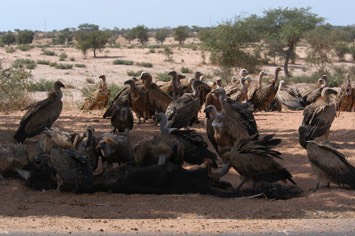
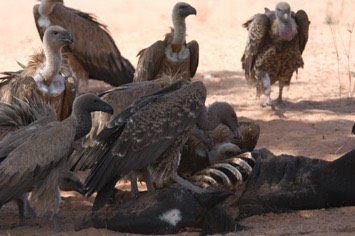
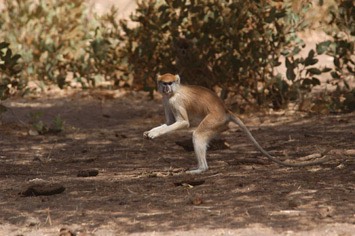
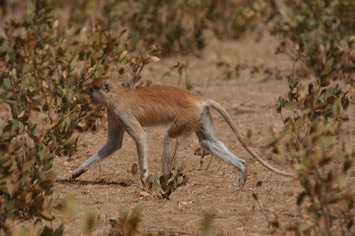
Sunday, 22/02/2004: Stationary at Zebrabar
We spent the whole day cleaning the tent and doing our laundry – for which we got teased by the other folks at Zebrabar. Wild drumming and music could be heard all night long from the village.
Monday, 23/02/2004: Trip from Zebrabar to St Louis and back, 41 km
We drove into St Louis for an oil change, internet and shopping. Maren insisted on buying a jar of Nutella for more than 7.50 Euro (Maren: That is because Mick is always eating half of it!)! We gave up on souvenir shopping as there were too many young hustlers in the town. On the way back, we stopped at the telecentre near Zebrabar, where the young manager remembered us from our previous visit – we gave him some money to buy a new football. We had brochettes and chips in the evening, with all the camp dogs gathered around, attracted by the smell of charcoal grilled meat. It rained slightly during the night – our first rain for quite some time.
Tuesday, 24/02/2004: Zebrabar – Diawling, 87 km
After buying some sand tracking from the owner we said farewell to Zebrabar. We drove to the border at Diama via the post office at St Louis. There was no trouble crossing but we had to wait some time to change money from CFAs to Ougiyas. We chatted with a Senegalese engineer who spoke German and told us the dam’s purpose was to prevent saline water running upstream. In the evening, we set up camp in the wilderness of Diawling where we saw warthogs and a jackal trotting past our camp.
Wednesday, 25/02/2004: Daytrip in the Diawling National Park, 152 km
We spent the day driving around Diawling National Park. The best spot to see birds was by a sluice gate on the Rosso piste, where we took loads of photos of cormorants, terns, kingfishers and herons. There were masses of catfish visible at the surface. Later we saw a heron with its foot caught on the hook of a long-line. We got a fisherman to rescue that one, but there was another dead on the same line. Driving around in the park, we saw a pair of jackals, cream-coloured coursers, sand grouse and gargany. We drove out to another wild campsite beyond the previous night’s one. Two parties of warthogs visited the camp and hundreds of crowned cranes flew by to roost.
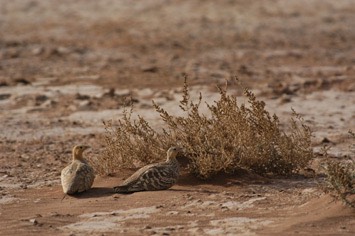
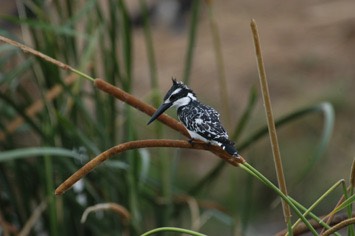
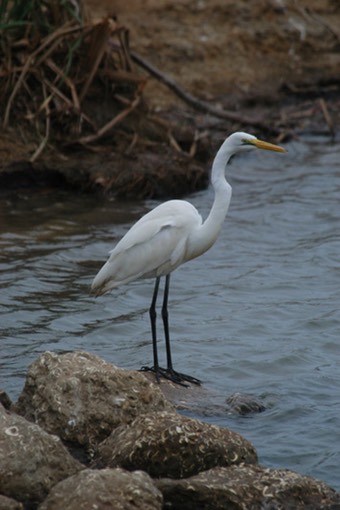
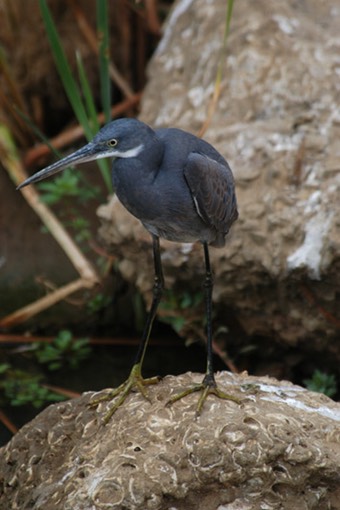
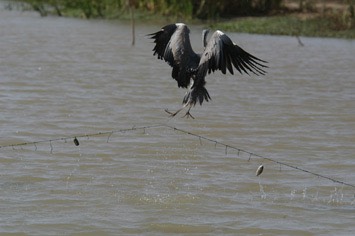
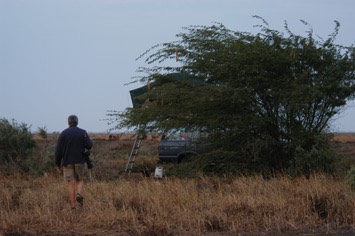
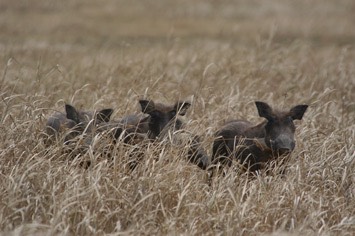
Thursday, 26/02/2004: Diawling – Nouakchott, 244 km
It must have rained during the night as there were damp patches of ground around, but fortunately we found a dry track out onto the main piste. We saw two Arabian bustards in the morning, more warthogs and large flocks of pratincoles. During a photo stop, Mick trapped his thumb in the car door – ouch! We drove on to Rosso, where we filled up before heading on to Nouakchott. A bunch of horrible kids gathered around the car at the filling station, so we gave up on the idea of filling up the jerry cans. In Nouakchott we stayed at the Auberge Menata, which was run by a young French woman. In the yard, they had a whale vertebra that they used as a seat, and she told us that it came from a large whale’s skeleton that friends found way off the sea in the Western Sahara. In the evening, we went out for a splendid meal at the restaurant Mediterranee, run by a Corsican.
Friday, 27/02/2004: Driving around Nouakchott, 38 km
We did some shopping and waited for the insurance man in the morning. Then we set off for Camping Tergit on the beach so we could get an early start driving along the beach piste the next morning. However, we discovered that there was no fuel to be had at any filling station in the city – that explained the queues we saw the previous evening! There had been no petrol for a week or so and diesel ran out the day before. Apparently the ship carrying fuel could not dock due to strong winds. Eventually we drove back to Auberge Menata to ask for help in finding fuel. Our Mr Fix-it – Hamane Sellama the insurance man – managed to acquire 20 litres of diesel from the military. It cost us 25 Euro and a packet of Marlboroughs, but at least we were not stuck in Nouakchott!
Saturday, 28/02/2004: Nouakchott – Nouamghar, 166 km
We poured the rather dirty looking military diesel into the tank before setting off at first light, only to get lost in the suburbs looking for the way out of Nouakchott. Eventually we found the new road north and followed it but missed the best piste to the beach and had to follow a very tortuous route through the dunes, but at last we made it and headed on up the beach. We stopped to record a stranded porpoise and two dolphins, one of which was a bottlenose dolphin and the other one we couldn’t identify. At some point we stopped, as the tide was nearing the top of the beach.. A low headland prevented us from continuing along the beach and the sand behind it appeared alarmingly soft. We used the time to look (and find) more dolphin bones. Suddenly, a Mercedes car appeared on the other side of the headland. It seemed to turn back but after a few minutes roared down through the sand behind us and sped on up the beach. Not to be outdone by a mere two wheel-drive car, we hastily set off and followed their tracks around the headland and back onto the beach again. We arrived at Nouamghar and went to the National Park office before driving out to the headland at Cap Timiris. There were flocks of thousands of terns, plus spoonbills, pelicans, gulls and many waders. It was extremely windy: a gale blew through the night causing the tent to flap so much that we couldn’t sleep.
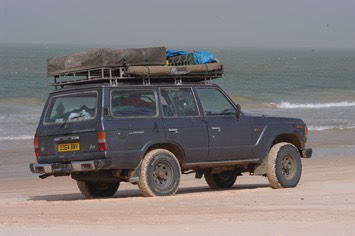
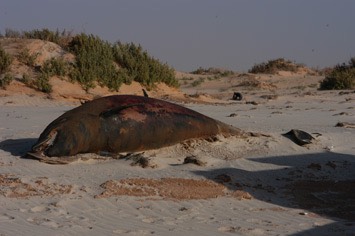
Sunday, 29/02/2004: Nouamghar – Cap Tagarit, 124 km
We would have liked to stay at Timiris, as it was an excellent bird hot-spot, but the strong wind was still blowing. We returned to the National Park Headquarters to measure and photograph the newly arrived third baleen whale skeleton. The jaw measured four metres from tip to tip and the overall length of the skeleton as displayed was 15 metres. We drove slowly along the shore of the Bay de St Jean, finding the remains of at least a dozen dead turtles, some nearly complete, others just a pile of bones. Later we left the beach and headed north, inland. We crossed a long stretch of gently undulating sand with a thin cover of grasses, where the piste was little used and hard to follow. But navigating by GPS waypoints we arrived at Iwik. This route seemed easier than the dune crossing on the way south, especially as the Harmattan wind was still blowing and the air was full of sand. At the National Park station in Iwik we found another large whale skeleton on display, together with a collection of dolphin skulls, one entire dolphin skeleton and a toothed whale jaw. Iwik looked unattractive in the sand-laden wind, so we carried on north to Cap Tagarit. Just north of the small village of Ten-Alloul we found the remains of at least eight turtles in a small rubbish dump. At Cap Tagarit Mick tried snorkelling, but the visibility was only half a metre due to the choppy seas. Then he tried fishing but caught only one small fish and let it go, then lost a second big one. So back to tuna curry for supper, which we ate in the moonlight. As we ate, a small fox appeared and started sniffing around where we had poured the oil from the tuna tin. It didn’t react when we shone a torch on it and in fact it walked right up to within two metres of us, apparently without fear. We had ample time to study it at close quarters – it was a small fox with large ears and long slender legs. It was a pale sandy colour with two dark spots on its face under the eyes and a white tip to its tail. Looking at the Kingdon field guide we identified it as a Ruppell’s fox, although we were outside the distribution for this species given in the book. The fox returned again a little later while Maren was having a pee, giving her a bit of a fright by its sudden appearance.
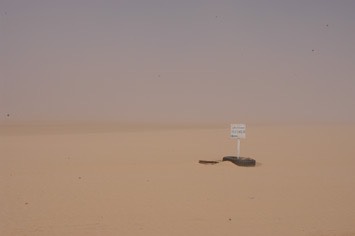
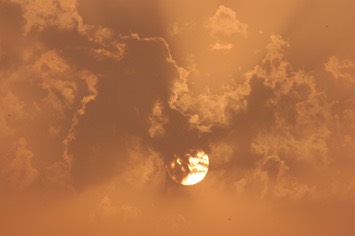
Monday, 01/03/2004: Cap Tagarit – somewhere in the desert, 77 km
We must have had more mammalian visitors during the night as there was a pair of tracks, possibly jackals, on the beach. It was still very windy, so we had to seek shelter in the car for part of the morning. Mick went fishing and caught two decent sized fish but fell in the sea, drowning one of the walky-talkies. Unable to communicate by radio, Mick had to run back to the car when he saw dolphins leaping close to the beach in the middle of the Tagarit – Tafarit bay. So we climbed up the headland to watch the dolphins, which at one point came to within 1 km of us. There were at least nine and possibly twelve bottlenose dolphins. At last! While having a late lunch a Hilux turned up with two men and a woman in it. The irate male passenger told us angrily that camping here was forbidden and that we should move on. He claimed to be from the National Park but wore no uniform. He wanted to stay and watch us pack the tent up but we told him we were eating and he left. We suspected that he ran the campsite at Tafarit, as financial loss seemed the only explanation for his behaviour. Not wishing to stay under the threat of his return, we packed up and moved on north. We camped in the desert among a lonely group of acacia trees – remnants of better times before the desert encroached this far south. We saw desert sparrows and migrating ospreys and swifts.
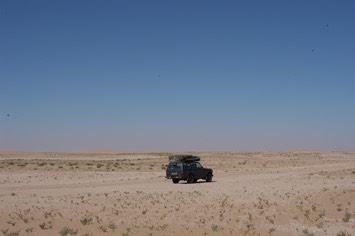
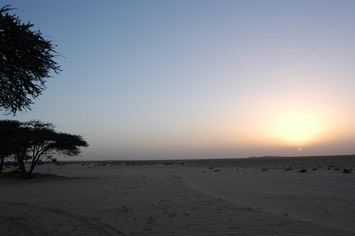
Tuesday, 02/03/2004: Desert – Nouadhibou, 117 km
We topped up with one jerry can before moving on. We made rapid progress through wind-swept desert until we came to the east side of the Baie de Levrier. There was a lot of fresh blown sand covering the tracks in the piste. As we neared the shore of the bay, the GPS indicated we should go left but the ground looked treacherous and most tracks seemed to go right. Indecision struck the driver and we ploughed into a dune of fresh blown soft sand, where we bogged down about 25 metres in. It took us five hours to retrace those 25 metres! At the first attempt we jacked the car up, got sand tracking under the wheels and reversed off optimistically, only to get bogged down again after five metres. The second time we tried the same with reduced tyre pressures but made even less progress. Meanwhile, we could see traffic moving not too far away... Jacking operations were extremely uncomfortable due to the strong wind blowing sand into every orifice of body and car. By the third attempt we seemed less than half way back off the low dune. On the fourth attempt we changed tactics and used our four short pieces of sand tracking on the rear wheels only, repeatedly moving the freed tracking back to reverse off one metre at a time. After more than five hours we finally made it to firm ground, totally knackered and thickly encrusted with sand. The good, hard piste turned out to be less than 50 metres away and we soon made it up to the railway line and arrived in Nouadhibou just before dusk. Ali’s compound was almost filled by a huge ”rolling hotel” bus full of Bavarians. Hot showers followed by chicken and chips at the “Les Trois Etoiles” made a very welcome end to the day.
Wednesday, 03/03/2004: Stationary at Nouadhibou
As sand was still pouring out of our ears and eyes and the interior of the car was chaotic, we decided to stay a day and get it sorted out. A couple of days ago a bad smell of rotten eggs suggested the demise of the stowaway mouse. However, freshly eaten mandarin suggested otherwise, so we took everything out of the car once more, finding plenty of evidence of rodent occupation, but still no mouse. At least we got the car sorted out and cleaned. We had a lazy afternoon, still recovering from the rigours of the day before. After returning from our evening meal at an Egyptian restaurant, we met a German couple from Kassel (near where Maren grew up) driving an old Mercedes car. She seemed quite nice, but he was a strange and rather unattractive character. It turned out that he makes his money by growing marijuana and spends it travelling, meanwhile complaining that the people at the job centre constantly try to find work or training for him! Throughout conversations with him, he constantly moved so close that we kept backing away, making faster progress across Ali’s compound than we did when digging the car out of the sand. He told us that his current quest was to collect meteorite fragments from the desert that might even turn out to be Martian rock that he planned to sell for a fortune, thus ensuring he never had to work again. Hmmm, must be good ganja he grows!
Thursday, 04/03/2004: (Nearly) Stationary at Nouadhibou, 14 km
The continuing sand storm reduced visibility so much we decided to stay another day rather than get lost in the mine field. We spent the morning writing the journal and chatting to the German woman. We set off towards Cap Blanc but aborted the trip as visibility was so poor. Ali asked Mick to find a newly arrived English group who spoke no French but apparently were looking for insurance. He found only one from the three car group. A little later Ali urgently called Mick to his car and they set off at speed in a mad quest for business. Ali sped out of the compound and turned left into the main road, driving up the left side of the road against the flow of traffic, weaving between cars in a desperate attempt to reach the British party. They were not in the insurance office so he did a U-turn and drove all the way back to the camp site, again on the wrong side of the road. Afterwards, we set off on foot towards Camping Abba, looking for a Scottie twin that had driven past earlier, and came across the English group on the way. We brought them back to drink tea in Ali’s tent where insurance was duly organised. One of them needed a yellow fever vaccination so Ali drove us to a clinic, but the doctor informed us he could neither give the vaccination nor provide malaria prophylaxis: both were available only in the capital.
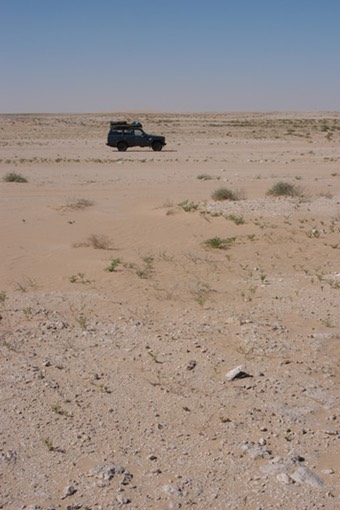
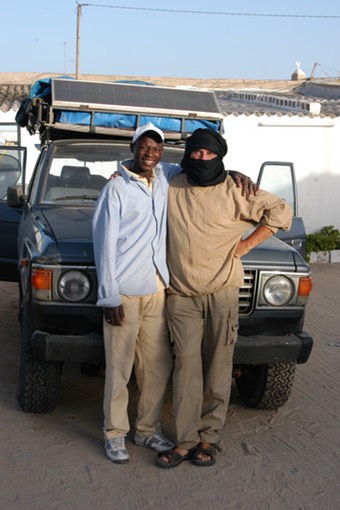
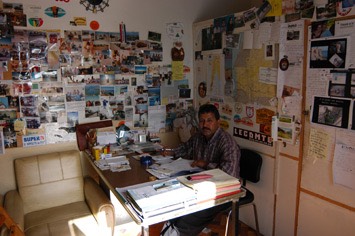
Friday, 05/03/2004: Nouadhibou – Whalebone Camp, 224 km
First thing in the morning Mick drove to Camping Abba to see the Scottie twin. The owner was delighted to see our car, as he had used photos from Chris Scott’s book to model his car on. After greasing the front ball joint that was leaking grease badly, we set off for the border. At the first checkpoint a policeman tried to persuade us to give him our solar panel. Stopping by the railway line for Maren to have a pee, we happened to pick the one time of day when the train passes by! It is supposed to be the longest train in the world – we counted 170 wagons. We had difficulty finding the beginning of our route through the minefield and had to reverse back some distance, but eventually found our track and had no problems from there on. The border crossings were swift, with no fees to pay and no cadeaux asked for. Once back in Morocco we made several attempts to find a new beach camp. We found dead turtles and many cetacean bones but nowhere really good to camp, so we ended up back in Whalebone Camp. Things seemed to have changed a bit due to shifting sands and we were greeted by the howling of jackals.
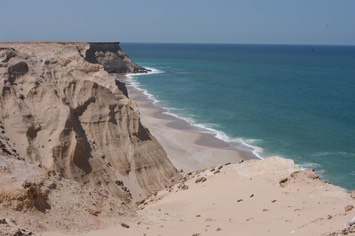
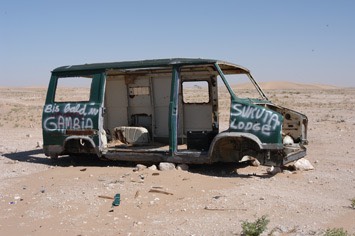
Saturday, 06/03/2004: Stationary at Whalebone Camp
Mick felt queasy all day, probably from drinking some dodgy wine the night before, so we spent the day stationary at Whalebone Camp. Maren walked up and down the beach in the morning, finding the remains of a harbour porpoise and a dead gannet. She also found the first clean porpoise skull of the trip, which of course we kept. After a rest she set off again in the afternoon, walking as far as the big jaw bone we had found on our previous visit. The beach had changed a lot over the past couple of months and small dunes had developed so that everything looked different. At least that meant several more bones and another skull had been revealed. We fell asleep to the sound of jackals in the night.
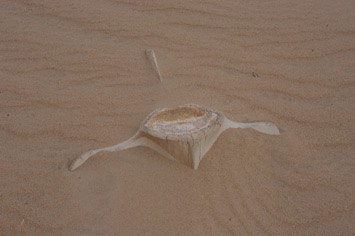

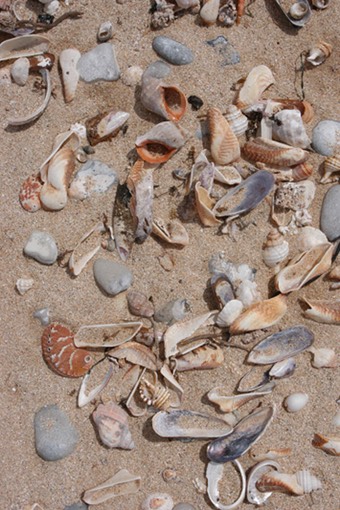
Sunday, 07/03/2004: Whalebone Camp – Dakhla, 234 km
We returned south to look at a few of the beaches we had passed on the way up from the border. At the first stop we walked about 400m of shore and found four whole or part skulls. One was definitely a porpoise and another was probably a calf, as the bones were extremely thin. It seemed likely that all four skulls were porpoises. At the next stop we recorded 13 ‘sightings’ of bones, which included vertebral fragments and the skull of a large whale, and three porpoise skulls. However, we were plagued by swarms of flies, so we drove on up to Dakhla. On the way we passed through an enormous swarm of locusts. There were thousands of dead locusts on the road and passing cars were thickly encrusted with dead locusts. We stopped to scan the sea for dolphins from the cliffs but saw none, despite many diving gannets. We saw lots of migrating birds along the way, including ospreys, marsh harriers, black kites, yellow wagtails, willow warblers and northern wheatears. We stayed at the campsite just outside Dakhla, which we shared with an Irish couple heading north and a Swiss couple heading south. We agreed to sell our (hopefully) now redundant sand tracking to the Swiss guy. The campsite owner spent a lot of effort chatting Maren up in German. It felt cold at night for the first time for a long time.
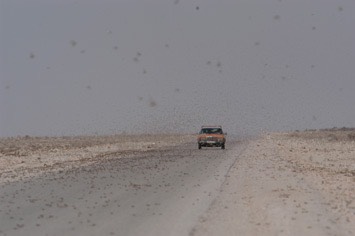
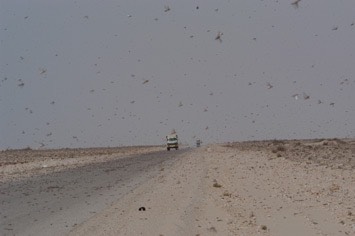
Monday, 08/03/2004: Dakhla – Boujdour, 306 km
The Irish couple reported seeing a mouse running away from the direction of our car the night before, raising hopes that we may have lost our stowaway. We went into Dakhla to buy insurance, only to find it was apparently unavailable here for foreigners, so we gave up and continued on our way. We drove to the beach just south of Boujdour, which has a tarmac road running down to it. As we were setting up our barbeque a smart Mercedes car arrived and we were greeted by the president of the district council, who proudly told us that the road down to the beach was his project. He took off his splendid jeleba for Mick to put on while we took some photographs. During a walk along the beach, we found more porpoise bones. There were subalpine warblers in the scrub and we flushed a tiny quail-like bird that was probably a button-quail. A strong wind got up again in the night, which sent things flying around and made it difficult to sleep.
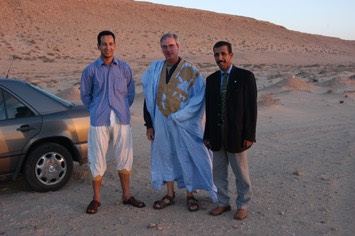
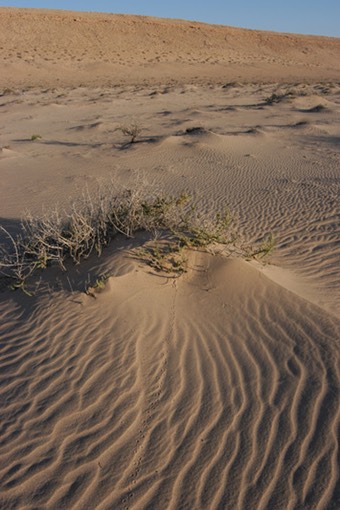
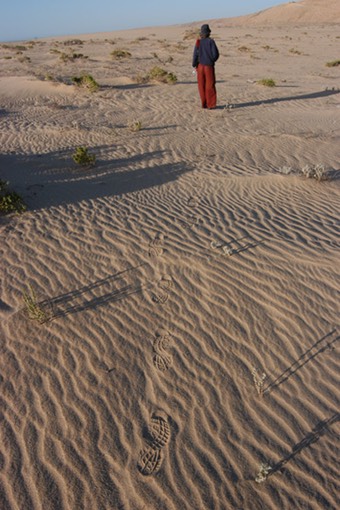
Tuesday, 09/03/2004: Boujdour – Tan Tan Plage, 442 km
We went for a short walk collecting shells on the beach before driving into Boujdour for breakfast. Then we went on to Layoune for lunch at a pizzeria. We continued on to Tan Tan Plage, where we booked into a hotel just a block back from the beach. We went out in the evening to eat and Mick had his hair cut by a cross-eyed bespectacled barber, who was a wizard with scissors and cut-throat razor.
Wednesday, 10/03/2004: Tan Tan Plage – Essaouira, 472 km
We drove from Tan Tan Plage to Essaouira. First we stopped to photograph the newly completed 3-D camels at Tan Tan. Our picnic lunch was eaten amid a vast swarm of locusts in the argan forests just north of Tiznit. Just north of Agadir we stopped briefly at the estuary at Tamri, but alas no waldrapps and virtually no birds at all. There was a fierce wind blowing so we decided not to camp on the coast as originally planned, but to carry on to the walled camping compound in Essaouira. That evening, while eating our tuna curry in the car, we heard strange noises from the back. Peering through the back window we at last saw our mouse, sitting on top of a fresh mango! We attempted to trap it by luring it into an empty water bottle using mango as bait, but it was too quick and jumped back out of the bottle when we jerked it upright with a long piece of string.
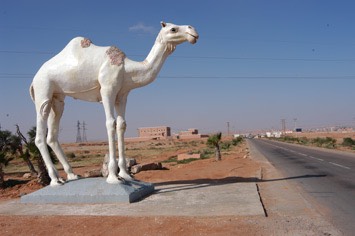
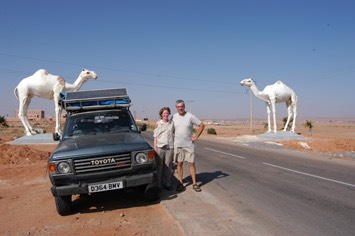
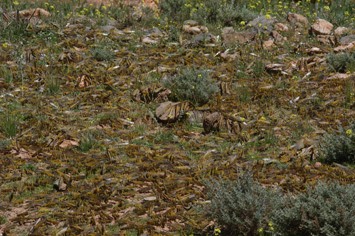
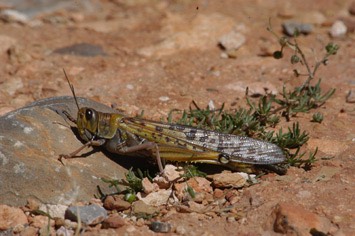
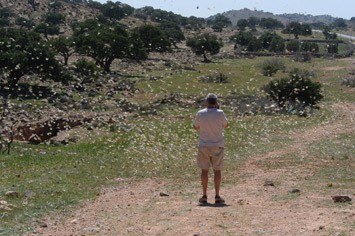

Thursday, 11/03/2004: Essaouira – Marrakech, 265 km
We turned south to the argan forest in the morning. Eventually we found some goats high in the trees which we wanted to photograph, well lit, on the right side of the road and with an old man as goatherd. After taking photos there we went on to visit the women’s co-operative at Tamanar to see how argan oil is made and to buy oil, soaps and various lotions. They dry the nuts in the sun and shred off the outer husks in old machines before each nut is laboriously cracked by hand to extract the kernels. These are then pressed to make the oil. We then drove east on a newly surfaced road through the High Atlas to Marrakech. We saw no other cars for hours, but enjoyed spectacular scenery, many wild flowers in bloom, saw a red fox, a snake and many birds, including the africana race of the chaffinch. We arrived in Marrakech in the late afternoon and found difficulty finding a hotel with secure parking, so ended up in the Ibis. In the evening we took a taxi to the Djem el Fnaa for a short walk in the souk before eating in the square. It was fun sitting there eating our brochettes while the stall holders called out in many different languages, trying to attract customers to come and eat. Afterwards we avoided snake charmers and performing monkeys, but listened to some Berber music before heading back to the hotel.
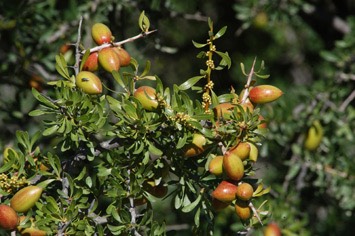
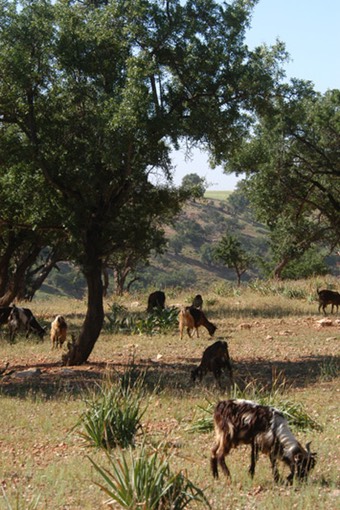
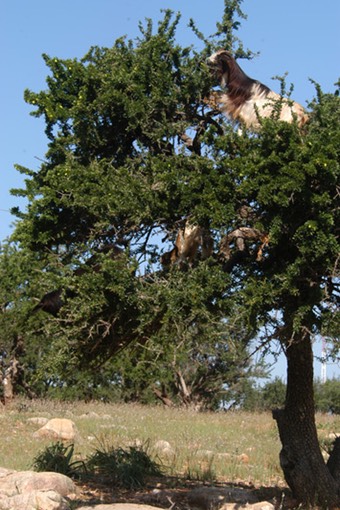
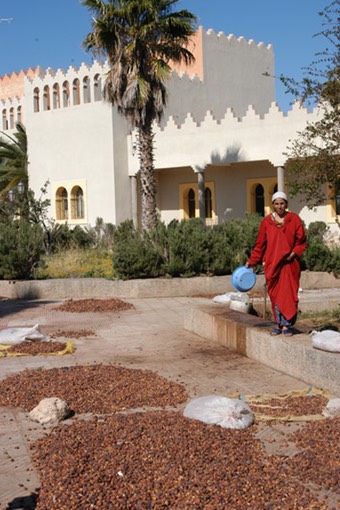
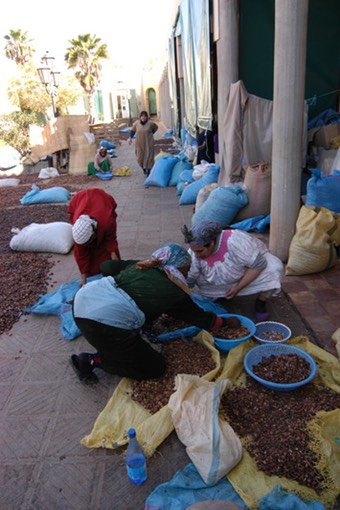
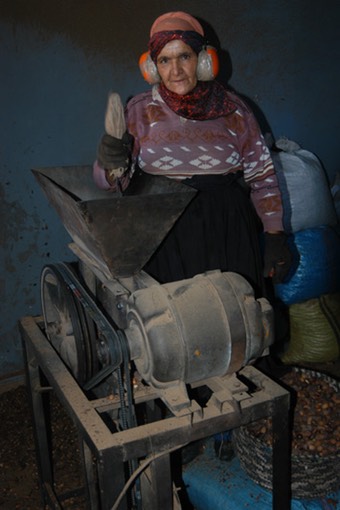
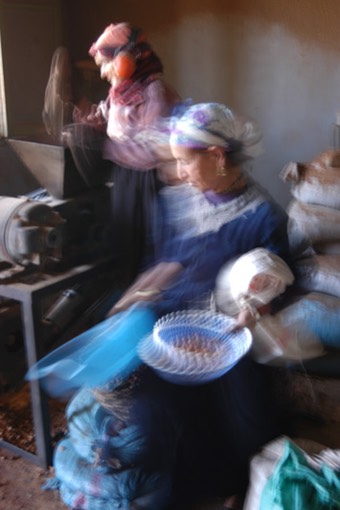
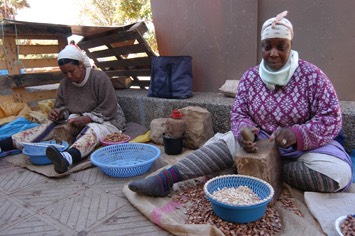
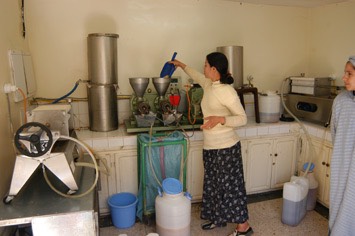
Friday, 12/03/2004: Stationary at Marrakech
We spent the day in Marrakech exploring the souks, although many stalls were closed, it being Friday. We met all kinds of weird and wonderful people. A “doctor” who spoke fluent German and English offered massages but seemed a bit too weird – his black anis cure for snoring nearly took the skin off the back of Mick’s nasal passages (and later proved to have the opposite of the desired effect!). Bargaining was fun. We seemed to do well putting up a hard fight in most cases, but the wooden spoon man simply refused to sell and said we should keep our money and he would keep his spoons! The slogan of the day was: “Small shop, small price, small profit.” Everyone was very welcoming and friendly, and impressed us greatly with their language skills. At the end of our visit, when we were very tired, a carpet salesman gave us the hard sell and seemed very morose when we did not buy in the end, despite repeating many times that we were under no obligation to buy. At least his assistant was amused at his master’s failure. After a rest at the hotel, we returned to eat in the Djem el Fnaa but it was cold, windy and cloudy, so the atmosphere was not as good as the previous evening. We had free teas at another stall after eating, just so we could fill some places and help them attract customers. We spent ages listening to Berber music that never seemed to get under way, but, after nearly an hour of wind-up, we were treated to about ten minutes of good drumming and singing with a young Berber girl dancing.
Saturday, 13/03/2004: Marrakech – Meknes, 421 km
We drove north to Meknes. At first the road was straight, level and busy but in the afternoon we climbed into the Middle Atlas, crossing a coll at 1462 metres in sleet, with patches of snow visible on the mountains. Much of the drive was through rain. We stopped to buy olive oil from one of the larger huileries. It was run by a young lady who gave us coffee, being happy to have some company on the weekend, and showed us around the farm, which kept cattle and goats. We ended up buying a box of 15 litres of olive oil, as the price and quality were both very good. It got dark before we arrived in Meknes so the last bit of the drive was rather stressful. We headed for the Ibis hotel to be greeted by extremely loud music.
Sunday, 14/03/2004: Stationary at Meknes
We walked from the hotel into the Meknes medina. Most stalls were closed when we arrived at 10am and it seemed dull after the vibrant souks of Marrakech. Alpine swifts and storks nesting in the medina walls were interesting however. Things livened up after some hours and we ended up in an extremely busy market that sold everything from clothes to fruit and vegetables. We became completely lost and knackered and ended up having to get a taxi back to the hotel. We hit the town in the evening for a delicious three course meal at “Le Dauphin”.
Monday, 15/03/2004: Meknes – Martil, 353 km
We set off for Ceuta via Fes and the mountain road over the Rif, which the German and British foreign ministries advise you not to take. We bought bread at a market in a small mountain village where no-one seemed to speak any French. We continued higher up into the mountains and found a place to pull off the road for lunch. Just as we finished eating, a smart new Hilux pulled in beside us and the driver did his best to persuade us in a mixture of Arabic and sign language, that we should go with him for a tour of his hashish farm, where we could also stay the night. He was very friendly but equally insistent. We thanked him for his generous offer but politely declined, saying we had to get to Ceuta that night. For the next 15 minutes he drove up the road ahead of us, stopping here and there trying to persuade us again with waves indicating we should pull in and look at places. Everyone on the road, whether on foot or in cars tried to wave us down, many holding up lumps of hashish they obviously wanted us to buy. Cars flashed their headlights and men held up two fingers in the peace sign. We passed through Ketama, which is reputed to be the centre of the hashish industry. It felt like a wild west town with badly potholed road and no sign of a policeman or anyone else in authority. The road climbed higher still (to more than 1600 metres) and there were patches of snow as we entered the clouds, where visibility dropped to less than 20m. Dropping down on the north side of the mountains we passed a suspicious-looking convoy heading in the direction of Ketama, consisting of several very expensive Mercedes cars accompanied by Hilux-type pickups. Was this a hashish baron off to make a big deal? Although everybody we came across was very friendly, it became rather tedious to be offered hashish every few seconds along the route, so we began the tactic of holding up a lump of chocolate to suggest we had already made our purchase. Judging by the reaction it seemed to work. Nevertheless, it was a relief to get to the wider roads and safer driving after Chefchouan – the worst aspect of the mountain road was the reckless behaviour of local drivers on the narrow roads. Few cars switched their lights on in the cloud and overtaking on blind bends seemed quite normal. The drive took a lot longer than expected and it was dark when we arrived at the campsite in Martil near Ceuta. We went out that evening for a last Moroccan meal.
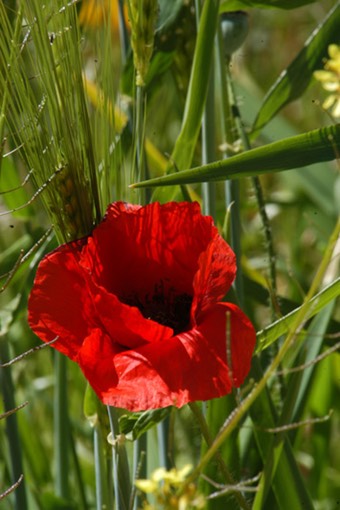
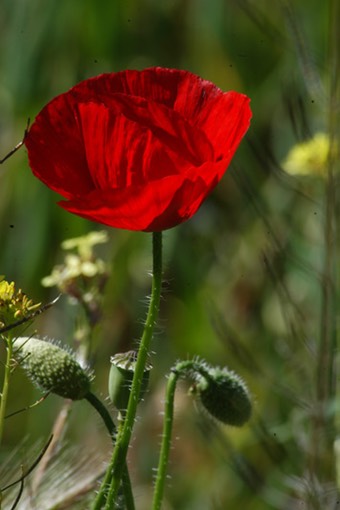
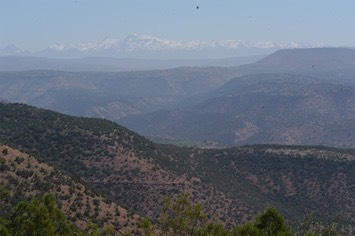
Tuesday, 16/03/2004: Martil – Jimena de la Frontera, 80 km
First thing in the morning we repacked the car, hiding all our skulls for the border crossing. The police waved us past a long queue of cars waiting at the Ceuta border. The crossing didn’t take long, nobody thoroughly searched the car and the sniffer dogs detected neither bones nor mice. Altogether we passed three sniffer dogs before we got out of the ferry terminal in Algeciras. Sea state was five and we saw nothing of interest on the crossing. We headed directly for the enormous Carrefour supermarket in Algeciras, before heading up to the campsite at Jimena, where we relaxed for the rest of the day.
Wednesday, 17/03/2004: Jimena de la Frontera to Tarifa and back, 134 km
We drove into Tarifa for an internet session and then back to Carrefour for more shopping. Our route to Tarifa took us on a small road that turned into a piste, where we saw a couple of Egyptian vultures. In the evening, we intended to walk into the village for supper but it was cold, so we got no further than the campsite restaurant. There were just five local guys there watching the Spanish cup final between Real Madrid and Zaragoza, so we joined them, asking for some tapas. First came a plate full of goulash and chips. Halfway through the match we were presented with a plate full of the most delicious Spanish sausage. After that came a plate each of beef, egg and wild mushrooms, picked that day by one of the guys. Together with several glasses of wine, two Fantas, a hot chocolate and a coffee, the bill finally came to 11 Euro.
Thursday, 18/03/2004: Jimena de la Frontera – Murcia, 483 km
Before setting off north we had to sort out insurance for Scottie, which had expired during our stay in Africa. This proved difficult, as officially UK insurance is only valid for three months on the continent and German insurance requires the driver to be officially registered in Germany. We ended up with British insurance and set off on the mountain road to Ronda. We saw a Little owl perched on a fence next to a dolmen in the mountains. After a picnic lunch by a lake, we pressed on via the motorway to Murcia, where we booked in to the newly opened Ibis hotel.
Friday, 19/03/2004: Murcia – Perpignan, 764 km
We drove up the motorway towards the French border but turned off at Figueres to take the coast road that winds along the rocky coast to Collioure. It’s a lovely looking bit of coast that we should go back to one day! We tried to find a campsite or cheap hotel, but all the campsites were closed and the hotels very expensive, so we ended up driving into Perpignon and staying in yet another Ibis hotel.
Saturday, 20/03/2004: Perpignan – Saintes Maries de la Mer, 247 km
We took the small roads into the Camargue, set up the tent in St Maries and went for a short walk in the evening. It felt really cold and we put our fleece on top of the duvet.
Sunday, 21/03/2004: Day trip through the Camargue, 115 km
We toured around the Camargue in the car in search of white ponies and birds. On the way to the night heron colony at Mas d’Agon we came across a group of loose ponies on the road. We were surprised to find the night herons had already arrived from Africa. Then we carried on to the information centre La Capeliere on the east side of the lake, where we walked around the nature trail spotting tree frogs.
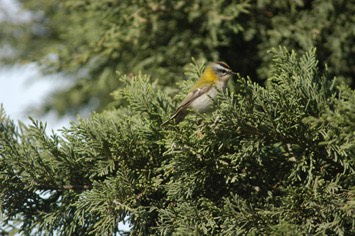
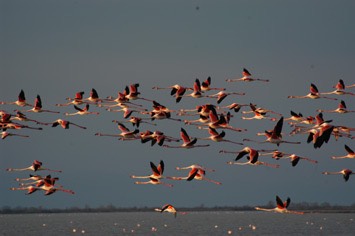
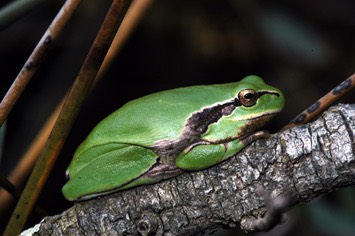
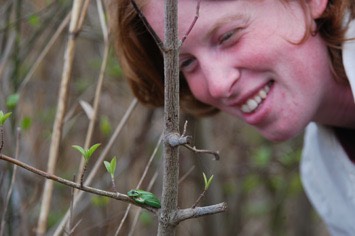
Monday, 22/03/2004: Day trip through the Camargue, 115 km
We set off for a walk around the second nature trail at Salin de Badon, just beyond the one we had walked the day before. It was a bit disappointing, with nothing much to see except redstarts, and we were plagued by mosquitoes and a cold mistral was blowing. The afternoon was spent searching for photogenic ponies, which we eventually found not far from St Maries. Maren climbed onto the roof to take pictures of fighting horses, which attracted the stares of passing locals. It was very cold but the results were worthwhile. We stopped in the village to visit the crypt in the church to see the black madonna (actually Saint Sarah).
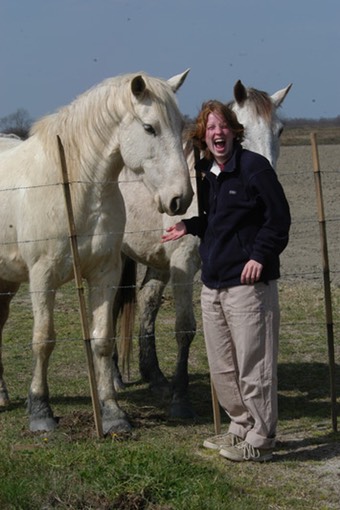
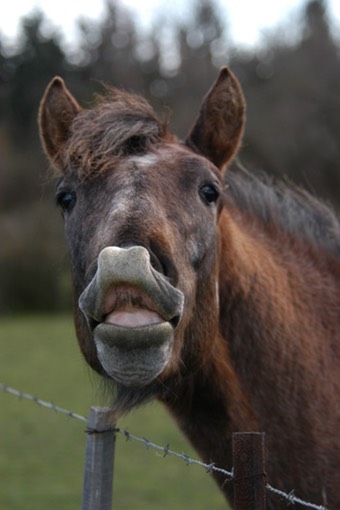
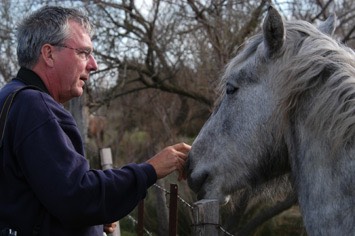
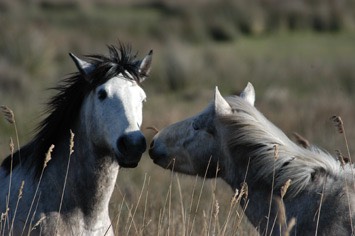
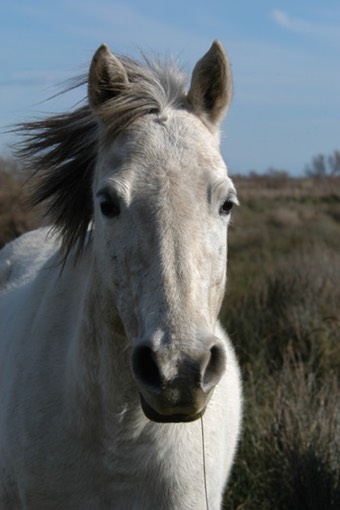

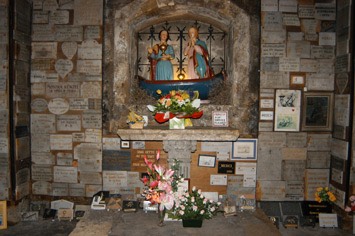
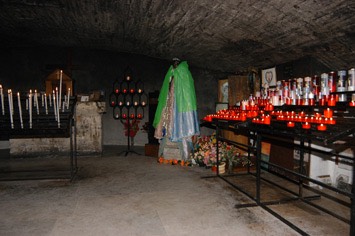
Tuesday, 23/03/2004: Saintes Maries de la Mer – Lure, 605 km
There were quite a lot of small migrant birds in the campsite, including firecrests, willow warblers and black redstarts. We drove north up the motorway. Towards the evening conditions deteriorated, with rain and poor visibility, so we left the motorway and eventually found a small hotel in Lure.
Wednesday, 24/03/2004: Lure – Malsfeld, 513 km
We crossed back into Germany and arrived at Maren’s parents house in Malsfeld at 16:00. We spent the rest of the evening telling traveller’s tales and started compiling our first picture show.
Thursday, 25/03/2004: Stationary at Malsfeld
We spent the day in and around Malsfeld. We had a quick look around the half-timbered buildings in Melsungen, the nearest town, but it felt seriously cold, so we returned to the warmth of the house and started a long, rather chaotic picture show. Eventually, we set a mousetrap in the car baited with mandarin.
Friday, 26/03/2004: Malsfeld – Bremen, 279 km
We woke up to a hard frost – it was -5ºC during the night! We had to scrape ice off Scottie before setting off. There was no mouse in the trap. We drove through driving snow to arrive in Bremen at 11:00. Have we made a big mistake in returning north so early?
POSTSCRIPT
Thursday, 08/04/2004
Today was a maintenance day for Scottie. Having bought new tyres and light bulbs, it was time to change the air filter. Pulling out the old air filter Mick found a few locust wings, then a rather bigger lump jammed against the filter opposite the air intake. It was furry to the touch – yes, incredibly enough, it was the mouse! The poor little guy had been sucked to death by the turbo-charged air intake. We tentatively identified it as a narrow-footed woodland mouse (Grammomys sp.), a fruit-eating tree-climbing species found in the Gambia.
